#but sometimes your story relies more on visuals/imagery. it's too bad.
Text
In another life I'd be making weird avant-garde films that get either 2% or 80% audience ratings
#i................ have an idea for a book. but i realize it might actually translate better on film.#i have many ideas but still#ugh. imagine me as a director! so cool!!!!#this film would be black and white until there's a smidge of colour that pops right out at you#cosmic horror just works better on screen sometimes. sometimes! i have written a fair amount of cosmic horror and i think it worked out.#but sometimes your story relies more on visuals/imagery. it's too bad.#i'm sure i can figure out a way to write this though#i don't share my ideas for original writing on tumblr though lol because of confidentiality
13 notes
·
View notes
Note
Hello! Feel free not to answer this question if it is in any way too much, but I've been wondering about something concerning the "western" mdzs fandom. Lately, i have seen multiple pieces of fanart that use what is clearly Christian symbolism and sometimes downright iconography in depicting the characters. I'm a european fan, but it still makes me vaguely uneasy. I know that these things are rarely easy to judge. I'm definitely not qualified to do so and was wondering if you have an opinion
Hi there! thank you for your patience and for the interesting question! I’ve been thinking about this since i received this ask because it?? idk, it’s difficult to answer, but it also touches on a a few things that I find really interesting.
the short answer: it’s complicated, and I also don’t know what I feel!
the longer answer:
i think that this question is particularly difficult to answer because of how deeply christianity is tied to the western art and literary canon. so much of what is considered great european art is christian art! If you just take a quick glance at wiki’s page on european art, you can see how inextricable christianity is, and how integral christian iconography has been in the history of european art. If you study western art history, you must study christian imagery and christian canon because it’s just impossible to engage with a lot of the work in a meaningful way without it. that’s just the reality of it.
Christianity, of course, also has a strong presence in european colonial and imperialist history and has been used as a tool of oppression against many peoples and nations, including China. I would be lying if I said I had a good relationship with Christianity--I have always faced it with a deep suspicion because I think it did some very, very real damage, not just to chinese people, but to many cultures and peoples around the world, and that’s not a trauma that can be easily brushed aside or reconciled with.
here is what is also true: my maternal grandmother was devoutly christian. my aunt is devoutly christian. my uncle’s family is devoutly christian. my favorite cousin is devoutly christian. when I attended my cousin’s wedding, he had both a traditional chinese ceremony (tea-serving, bride-fetching, ABSURDLY long reception), and also a christian ceremony in a church. christianity is a really important part of his life, just as it’s important to my uncle’s family, and as it was important to my grandmother. I don’t think it’s my right or place to label them as simply victims of a colonialist past--they’re real people with real agency and choice and beliefs. I think it would be disrespectful to act otherwise.
that doesn’t negate the harm that christianity has done--but it does complicate things. is it inherently a bad thing that they’re christian, due to the political history of the religion and their heritage? that’s... not a question I’m really interested in debating. the fact remains that they are christian, that they are chinese, and that they chose their religion.
so! now here we are with mdzs, a chinese piece of media that is clearly Not christian, but is quickly gaining popularity in euroamerican spaces. people are making fanart! people are making A LOT of fanart! and art is, by nature, intertextual. a lot of the most interesting art (imo) makes deliberate use of that! for example (cyan art nerdery time let’s go), Nikolai Ge’s What is Truth?

I love this painting! it’s notable for its unusual depiction of christ: shabby, unkempt, slouched, in shadow. if you look for other paintings of this scene, christ is usually dignified, elegant, beautiful, melancholy -- there’s something very humanizing and humbling about this depiction, specifically because of the way it contrasts the standard. it’s powerful because we as the audience are expected to be familiar with the iconography of this scene, the story behind it, and its place in the christian canon.
you can make similar comments about Gentileschi’s Judith vs Caravaggio’s, or Manet’s Olympia vs Ingres’ Grande Odalisque -- all of these paintings exist in relation to one another and also to the larger canon (i’m simplifying: you can’t just compare one to another directly in isolation etc etc.) Gauguin’s Jacob Wrestling the Angel is also especially interesting because of how its portrayal of its content contrasts to its predecessors!
or! because i’m really In It now, one of my favorite paintings in the world, Joan of Arc by Bastien-Lepage:

I just!!! gosh, idk, what’s most interesting to me in this painting is the way it seems to hover between movements: the hyperrealistic, neoclassical-esque take on the figure, but the impressionistic brushstrokes of the background AAA gosh i love it so much. it’s really beautiful if you ever get a chance to see it in person at the Met. i’m putting this here both because i personally just really like it and also as an example of how intertextuality isn’t just about content, but also about visual elements.
anyways, sorry most of this is 19thc, that was what i studied the most lol.
(a final note: if you want to read about a really interesting painting that sits in the midst of just a Lot of different works, check out the wiki page on Géricault’s Raft of the Medusa, specifically under “Interpretation and Legacy”)
this is all a really long-winded way of getting to this point: if you want to make allusory fanart of mdzs with regards to western art canon, you kind of have to go out of your way to avoid christian imagery/iconography, especially when that’s the lens through which a lot of really intensely emotional art was created. many of my favorite paintings are christian: Vrubel’s Demon, Seated, Perov’s Christ in the Garden of Gethsemane, Ge’s Conscience, Judas, Bastien-Lepage’s Joan of Arc, as shown above. that’s not to say there ISN’T plenty of non-christian art -- but christian art is very prominent and impossible to ignore.
so here are a few pieces of fanwork that I’ve seen that are very clearly making allusions to christian imagery:
1. this beautiful pietà nielan by tinynarwhals on twitter
2. a lovely jiang yanli as our lady of tears by @satuwilhelmiina
3. my second gif in this set here, which I will also show below:
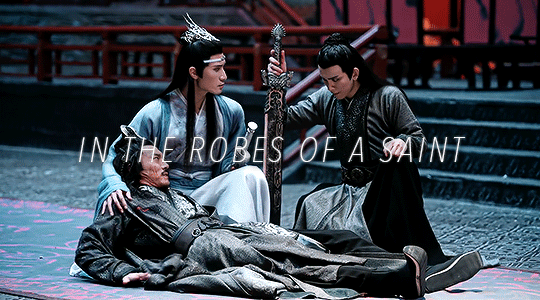
i’m only going to talk about mine in depth because well, i know exactly what i was thinking when I put this gif together while I can’t speak for anyone else.
first: the two lines of the song that I wanted to use for lan xichen were “baby, I’m a fighter//in the robes of a saint” because i felt that they fit him very well. of course, just the word “saint” evokes catholicism, even if it’s become so entwined in the english language that it’s taken on a secular meaning as well.
second: when I saw this scene, my immediate thought was just “PIETÀ!!” because LOOK at that composition! lan xichen’s lap! nie mingjue lying perpendicular to it! the light blue/white/silver of lan xichen in contrast to the darker robes of both nie mingjue and meng yao! not just that, but the very cool triangular structure of the image is intensely striking, and Yes, i Do love that it simultaneously ALSO evokes deposition of christ vibes. (baxia as the cross.... god..... is that not the Tightest Shit) does this make meng yao joseph of arimathea? does it make him john the evangelist? both options are equally interesting, I think when viewed in relation to his roles in the story: as a spy in qishan and as nmj’s deputy. maybe he’s both.
anyways, did I do this intentionally? yes, though a lot of it is happy accident/discovered after the fact since I’m relying on CQL to have provided the image. i wanted to draw attention to all of that by superimposing that line over that image! (to be clear: I didn’t expect it to all come through because like. that’s ridiculous. the layers you’d have to go through to get from “pretty lxc gifset” --> “if we cast nie mingjue as a christ figure, what is the interesting commentary we could do on meng yao by casting him as either joseph of arimathea or john the evangelist” are like. ok ur gonna need to work a little harder than slapping a song lyric over an image to achieve an effect like that.)
the point of this is: yes, it’s intentionally christian, yes I did this, yes I am casting these very much non-christian characters into christian roles for this specific visual work -- is this okay?
I obviously thought it was because I made it. but would I feel the same about a work that was written doing something similar? probably not. I think that would make me quite uncomfortable in most situations. but there’s something about visual art that makes it slightly different that I have trouble articulating -- something about how the visual often seeks to illustrate parallels or ideas, whereas writing characters as a different religion can fundamentally change who those characters are, the world they inhabit, etc. in a more... invasive?? way. that’s still not quite right, but I genuinely am not sure how to explain what i mean! I hope the general idea comes across. ><
something else to think about is like, what are pieces I find acceptable and why?
what makes the pieces above that reference christian imagery different than this stunning nieyao piece by @cyandemise after klimt’s kiss? (warnings for like, dead bodies and vague body horror) like i ADORE this piece (PLEASE click for fullview it’s worth it for the quality). it’s incredibly beautiful and evocative and very obviously references a piece of european art. I have no problem with it. why? because it isn’t explicitly christian? it’s still deeply entrenched in western canon. klimt certainly made other pieces that were explicit christian references.
another piece I’d like to invite you all to consider is this incredible naruto fanart of sakura and ino beheading sasuke after caravaggio’s judith. (warnings for beheading, blood, etc. you know.) i also adore this piece! i think it’s very good both technically and conceptually. the reference that it makes has a real power when viewed in relation to the roles of the characters in their original story -- seeing the women that sasuke fucked over and treated so disrespectfully collaborating in his demise Says Something. this is also!! an explicitly christian reference made with non-christian japanese characters. is this okay? does it evoke the same discomfort as seeing mdzs characters being drawn with christian iconography? why or why not?
the point is, I don’t think there’s a neat answer, but I do think there are a lot of interesting issues surrounding cultural erasure/hegemony that are raised by this question. i don’t think there are easy resolutions to any of them either, but I think that it’s a good opportunity to reexamine our own discomfort and try and see where it comes from. all emotions are valid but not all are justified etc. so I try to ask, is it fair? do i apply my criticisms and standards equally? why or why not? does it do real harm, or do i just not like it? what makes one work okay and another not?
i’ve felt that there’s a real danger with the kind of like, deep moral scrutiny of recent years in quashing interesting work in the name of fear. this morality tends to be expressed in black and white, good and bad dichotomies that i really do think stymies meaningful conversation and progress. you’ll often see angry takes that boil down to things like, “POC good, queer people good, white people bad, christianity bad” etc. without a serious critical examination of the actual issues at hand. I feel that these are extraordinarily harmful simplifications that can lead to an increased insularity that isn’t necessarily good for anyone. there’s a fine line between asking people to stay in their lane and cultural gatekeeping sometimes, and I think that it’s something we should be mindful of when we’re engaging in conversations about cultural erasure, appropriation etc.
PERHAPS IT IS OBVIOUS that I have no idea where that line falls LMAO since after all that rambling I have given you basically nothing. but! I hope that you found it interesting at least, and that it gives you a bit more material to think on while you figure out where you stand ahaha.
was this just an excuse to show off cool (fan)art i like? maybe ¯\_(ツ)_/¯
(ko-fi)
#Anonymous#asks and replies#art#fanart#art history#christianity#mdzs#mdzs meta#meta#mine#mymeta#cyan gets too deep in the weeds#lmfao this post is a mess ive been staring at it for like a week and at this point im just gonna post it to the wall and keep moving asldfj#hope you enjoyed
316 notes
·
View notes
Text
Calling it right now: Luka will sacrifice himself for Marinette/Ladybug in the “Miracle Queen” finale.
Was thinking about this theory way too hard on my Sunday afternoon, and felt the need to share the pain with Tumblr (you’re welcome!).
Spoilers (for Love Eater/Heart Hunter and Kwami Buster) and pain under the cut!
It’s already been well-established in the prior episodes that Marinette relies on Luka for emotional support (see “Captain Hardrock”, “Frozer” and “Silencer”), and some have pointed out this moment in “Desperada” as an indication that Luka has caught onto Ladybug’s secret identity:
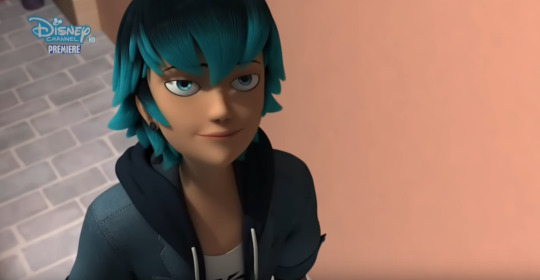
I firmly believe the interplay of Luka and Marinette’s relationship, as well as this possible identity suspicion in “Desperada” serve as foundation for what’s to/has unfolded in the season 3 finale. This, what we’ve seen in “Love Eater/Heart Hunter”, and the alleged fact that the Miraculous crew were “moved to tears” by the final episode all point towards this conclusion: something tragic will happen in the finale, and they’ve developed Luka as the perfect martyr.
Disclaimer: Before Luka fans get mad, please understand that this is not a Luka hate post. I’m also a Luka fan, and I want nothing but the best for my guitar playing, slightly cheesy, teeth-rottingly sweet boy. But the (unfortunately shallow) character arc for Luka seems to foreshadow nothing but bad things for his future :( I hope I’m proven wrong when the finale airs in December, but until then, I am convinced bad things will happen to him.
Ok, let’s start from the beginning. “Love Eater/Heart Hunter” (I’m going to call the episode Heart Hunter from now on) starts off with Marinette’s narration, and it’s interesting to see who they choose to focus on the most during her monologue:
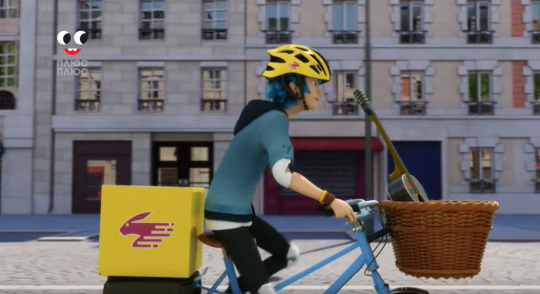
“And some have nothing to lose”, Marinette narrates as we see a happy Luka. He’s humming what is likely one of his drafts of Marinette’s ‘melody’, looking cheerful as usual.
What do we cut to in the next scene?

We all know that Marinette is (almost unrealistically) superhuman when it comes to multitasking and coping with pressure. But we are also reminded at certain points in the series that she’s only human. Despite her ingenious plans and effusive energy, she also makes mistakes and sometimes needs help from others. This scene where she trips while she’s carrying a stockpile of boxes for her parents (bless her soul) is a perfect microcosm of what the writers are trying to convey with Marinette’s character design: she often carries more on her shoulders than she can handle.
And guess who appears to help her out?
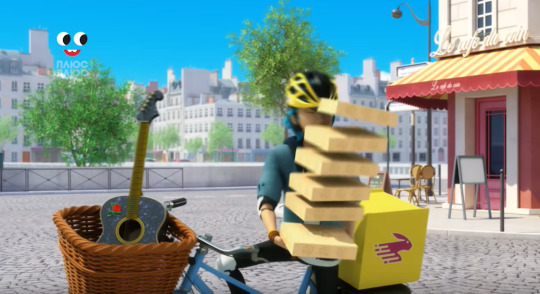
As I’ve mentioned before, from the storywriter’s POV, Luka serves as emotional support for Marinette. His prior development in “Silencer” showed just how far he was willing to go for Marinette’s happiness: even though he was controlled by an akuma, the passion and devotion he felt for Marinette was all from him. And this scene in Heart Hunter is a reminder of his ‘role’ when it comes to Marinette. He is her support.
Notice how the frame also includes the guitar in his basket. Luka is not a man of many words, choosing rather to express himself through music. In a way, his guitar is his soul, the medium he relies on to communicate his emotions – especially towards Marinette. The scene focuses even more on the guitar as he uses it to strum a song for Marinette, which becomes important at the end of the episode.
But before that, we get this adorable sequence:


Luka gives her a helmet and drives her to the hotel. Marinette hangs onto him from the back while wearing said helmet. Why include the helmet sequence? Other than instilling a message of bike-riding safety (Which is actually very important! Falling on your head without a helmet sucks, not that I’d know.), I think the animators were trying to hint at something else. Keep reading.
The rest of the episode unfolds badly for Marinette. She third-wheels on Adrien’s date with Kagami, sees Cat Noir growing distant from her, and suspects that she’s put Fu in danger. It’s a lot for person – let alone a teenager – to handle, and cracks start to form in her façade of nonchalance.
Who appears again when her stress is at its worst?

Other than the obvious fact that Luka comes to the rescue, let’s note how the guitar is not only a part of the frame this time, but its visual focal point:

The animators really want us to focus on that guitar, huh? If you’re still skeptical, guess what happens when Luka walks over to Marinette.

His bike falls over, the camera pans over to the guitar (again!) falling along with the helmet. And they’re both conveniently placed at the dead center of the camera shot. Why focus on the falling bike and the scattered items? Because they’re supposed to tell us something.
They fall when Luka loses his grip on the bike as he walks over to comfort Marinette. It shows how focused he was on comforting Marinette, prioritizing this over salvaging his items from the fall. As I’ve said before, Luka is a passionate, devoted person. And he feels these emotions for Marinette, almost putting her on a pedestal of sorts for the sake of making her happy (letting her go after Adrien in “Frozer”, resorting to criminal acts for Marinette’s sake in “Silencer”, etc.). This scene is a perfect visual illustration of the extent Luka is willing to go to for Marinette’s sake. He’s willing to ‘take the fall’ for her when it comes to making her happy.
The guitar is an obvious symbol of Luka himself, given his penchant for the instrument. But what about the helmet?

This scene shows the answer. Luka is giving her protection and will continue to do so into the next episode (hence why the episode ends on this scene). At this time, he’s protecting her in an emotional way, literally shielding her from the rest of the world as he embraces her and lends a listening ear.
The episode concludes with a shot centered around Luka, and I think that’s something significant to note. Heart Hunter starts and ends with shots focused on someone who honestly wasn’t that instrumental to its plot. Why? Because Heart Hunter is only the first part of a two-parter finale, and these shots serve as foreshadowing for Luka’s importance in the second part.
I mentioned before that Luka may suspect Ladybug being Marinette, and this is the perfect place for the writers to tie that back into the storyline. Marinette has just been driven over the edge due her thinking she has failed as Ladybug, and Luka is offering to listen to her problems. Whether Marinette will choose to disclose her identity in the process of alleviating her anxiety is admittedly still uncertain. But given how the finale provides the perfect opportunity for this drama to go down (see my comments about the crew’s reception to the finale) I am thinking that Luka will be let it in on Marinette’s secret in the next episode.
This, along with the consideration that Luka has already wielded a miraculous, makes me think that Luka will hold a significant, protective role in the upcoming story: a tragic hero’s role. Luka’s altruistic characterization, as well as Heart Hunter’s unsettling imagery point towards the possibility that he’ll put himself in danger for Marinette/Ladybug’s sake.
My shot in the dark is that he’ll attempt to wield both the ladybug and cat miraculouses in order to defeat Hawkmoth and Mayura; who may attempt to use the miraculouses they’ve just stolen from Fu. Marinette has been shown to be able to handle using multiple miraculouses, but it’s also been explicitly stated that this is a dangerous practice that requires physical and mental fitness. I am not so sure if she meets the latter requirement at this point in time due to the events of Heart Breaker, so Luka may offer to help her out. And she may let him help her.
Even though Marinette was successful in using multiple miraculouses in “Kwami Buster”, we also saw how exhausting this was for her. I can’t even imagine what doing the same would do to Luka, especially if their battle against Hawkmoth/Mayura is prolonged (as they are always in finales). My guess is that Luka will suffer consequences similar to Emilie’s, going comatose as a result of misusing miraculouses. For the writers, this is the perfect hurricane of drama needed to stir up the fandom but not jeopardize their future seasons/the love square: have the secondary love interest find out Ladybug’s identity, and then remove him from the equation once and for all by having him make the ultimate, tragic sacrifice for Ladybug. After all, he has “nothing to lose”, right?
Again, this is not a Luka hate post, and I want to make that abundantly clear. I personally hope I’m reading too much into this and that I’m proven wrong in December. But how the writers have characterized Luka so far in the series and in Heart Breaker makes me really anxious. :(
Prayer circle for Marinette AND Luka.
#miraculous ladybug#ml#luka couffaine#marinette dupain cheng#lukanette#love eater#kwami buster#ml 3.25#ml spoilers#love eater spoilers#heart hunter#heart hunter spoilers#s3 spoilers#kwami buster spoilers#spoilers#miraculous theory
537 notes
·
View notes
Text
More disorganized thoughts on Dublin Murders (eps 3-6)
(As before, lots of books-centric talk and speculation that may be spoilery.)
I feel like I should begin by giving Phelps a bit of credit in that it does seem clear enough, even in the changes from French, that she is an enthusiast and has probably read this series over and over aside from professionally. There are times when I smile because it’s so obvious she’s a fan, but then there are other moments...we’ll get there.
I feel like it’s always a little...bad or whatever to bag on child actors, but ugh, with the exceptions of some minor ones I just can’t with these miscast kids. I can’t with that cheesy decision to have Adam yelling and yelling when they find him in the woods (the nail-breaking catatonia was so much creepier, come on). This slightly deranged stuff with little Cassie and Lexie is another quick shortcut for the viewers who can’t piece together psychological implications for themselves--it’s that stuff that makes me wonder if relying on a lot of voiceover would have actually been more subtle. Yes, Cassie had an imaginary friend when she was little because she felt alone after her parents died, but that isn’t spelled out in a couple clauses like I just did, or like the series basically does in two minutes with a strangely emotionless scene they were so proud of we had to watch it twice just in case the ins and outs of her formative trauma wasn’t clear enough.
How depressing to think of a kid buried with their favorite color when kids change their minds about their favorite color every few months. That being said, my mom somehow always kept it straight! Something’s not right in that house, man.
The thing with McCabe being haunted about Knocknaree till his death and leaving crackers notes in the evidence is a little corny but I like it. And like, Rob saying it’s irrelevant but clearly being shaken to hear that...and Christ, that bit later on when he makes up a probable suicide for Adam Ryan...boy.
Oh my LORD can we talk about how Rob is so cold with his mom?? Cassie was more affectionate with her than he was. That scene is so sad, it’s perfect. And no shit, when she told Cassie she wasn’t a good liar, I scoffed at that...and then she told Rob and they both laughed about it <3 <3
It’s been commented on, but Rob has a key to her place? He comes over to wake her up with coffee, and he’s about to leap in his car and come to her after she sees Lexie’s body, because of course he would have (while Sam awkwardly tries to approach her over her shoulder, lolll). Their platonic intimacy, I just... <3<3<3
LOL @ O’Kelly reacting to Lexie the way more people probably would: “Are you all on ketamine?! Am I the only one looking at this?!!?”
“You get to know his tell.” That’s mean for my Cassie but

I gotta say, I’m less annoyed than I was when it happened but still annoyed that Rob and Cassie sleeping together happened with her emotions as the catalyst rather than his. Like it makes enough sense if you believe the whole complication was going to happen sooner or later, but it really backs away from the part of In The Woods where Rob is at his most absolutely naked vulnerability and is clearly capital ‘t’ Triggered and it might significantly compromise how sympathetic he can be, and what his development does with male trauma. At least they do make him cry later, and remembering witnessing the rape works as a stand-in for what brings that on, but it’s undeniably disappointing to not see him go through that raw breakdown with Cassie in a way that feels in multiple ways like a tragically brief lapse in his walls.
Sam? Goading Cassie into admitting she slept with Rob after they’d fallen out and then saying “Fuck you, I have to work with him”? More likely than you think. Nah, I don’t know, these two were practically incapable of being harsh with each other in the novel and it’s...unexpected. It’s interesting because it’s like here we are treating Sam’s idealization of Cassie as more obviously a Problem while it was more just an annoyance in The Likeness, but I don’t really see book!Sam having this level of breakdown like he hardcore has been in denial that Cassie has probably done some stuff she’s not proud of, so they’re very different in my mind.
HOLLY, though. Holly actually knows Cassie like in the fanfic I’d like to read. Frank’s cheesy Dad shirt! This is the shit that makes me feel that Phelps is a Fan. But like, what is her deal with The Likeness because she doesn’t seem to dive into the things that a lot of the fans love about that book at all? I know they’re short on time (because of who’s choice to condense these in one miniseries, I’d like to know) but there’s a reason the book takes its time with the prep of the operation. With this, we mostly get some cursory stuff about where the kitchenware goes and one bit with a videotape and like...I have no clue how Cassie thinks she knows what Lexie is like, and because of that weird-ass talk with Sam where she seems disconnected from reality about where she came from and Frank showing little concern about how to instruct her to do this and the totally anti-climactic way she arrives at Whitethorn House and they just SKIP TO THE NEXT MORNING like it’s all no big deal, it’s almost like we’re not supposed to care or even think about the central fulcrum of suspense and audaciousness that made the premise of the book so fucking good.
But that’s not even half the problem, because the Whitethorn characters are just kinda lost on this take. So far I either haven’t noticed or haven’t much liked the cast’s performances of them, their connections are simplified to who's banging or wanting to bang who right away, and there’s a sad shortage of actual non-awkward warmth before we get to those fissures of ugliness and resentment. And you know, the worst of it is that Cassie doesn’t give a fuck. She wants to nail one of them to the wall, she believes from the beginning one of them did it, and that’s a completely different story that doesn’t really need all this surreal gothic pomp which is already a lot to swallow in the same season as In The Woods. She and Frank are totally on the same wavelength and that’s fun to watch because sometimes that’s the fundamental note of their sense of intense history in the book too, but in The Likeness, Frank has this contempt for the residents that says more than he realizes about himself, and she has this desire to protect this strange family from the inevitable which says something about her and everything she’s been through, and that comes around in so many ways that I doubt they’re going to suddenly establish in the last couple episodes, unfortunately.
I will say though, while I figured that pulling these two relatively insulated high-concept stories together wouldn’t work and it doesn’t seem to be working, I am enjoying how much it emphasizes the thematic threads and imagery shared between them, even things like doubles/twins. Even though at least one of Rob’s hallucination sequences doesn’t land right for me, I love the visuals always emphasizing that insurmountable intrusion of the woods and the feral world, most literally realized in that horrifying car crash in slow motion. It makes me think of Scorcher’s “Wild stays out” bit--inevitably it doesn’t~~
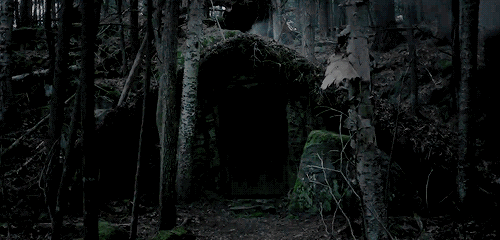
And at the same time, Cassie leaving Rob to go under is a different way of approaching that pile of angst that I’m finding interesting and I look forward to seeing how they tie everything back in.
Though I did kinda like that one scene with O’Kelly, I have a big bone to pick with that “Mackey gets people killed” thing, because...no? Dead operatives don’t get “results.” You’re not a badass like Frank Mackey is supposed to be if you can’t pick the undercover types and teach your cops how to not get killed, because you get to that point by being good at not getting yourself killed. Mackey even says at one point in Faithful Place with some defensive pride that his moles don’t end up dead. Frank is shady and opportunistic and manipulative, but he is not a fucking idiot, and making him hold the bad-guy ball to just shrug about the gun in ordeI’r to remove--even more!--the emphasis on Cassie’s increasingly compromised and reckless decisions is not something I’m happy with (I’ll admit I’m not 100% sure about this, but she keeps it from him in the book, right?).
Hmm: “If anything happens to her I'll fucking kill you” vs. “Maddox is a survivor.”
Also: “She looks at Daniel the way Sam looked at you.” Aww, Frank, you bastard.
I forgot to say last time that Rob having a roommates-with-hate-sex-benefits thing with Heather is just...yeah, that could happen. But what was up with her not even noticing he looks like he needs an ambulance, lol
I stopped at quite a cliffhanger so I think I’ll just end this here.
#dublin murders#dublin murder squad#cassie maddox#frank mackey#rob reilly#rob ryan#tana french#Layla very occasionally liveblogs#yeah sorry I can't figure out how to do a cut on here anymore
25 notes
·
View notes
Text
“Another Life” Review: Another Hour of Mine I Won’t Get Back
One of the good things about Netlix (particularly compared to traditional TV channels) is that its ability to deliver a wide variety of content simultaneously allows it to experiment with things that might not have wider appeal. This is particularly important where genre fiction is concerned, because you can’t rely on formula to develop something genuinely good in that area. Who’d have thought that a ‘cursed object’ story set exclusively in the art world where everyone talks like they’re delivering a devastating Gustav Klimt review would turn out to be one of the best horror movies of recent years? And yet Velvet Buzzsaw blew me away and gave me a reason not to give up on western culture completely. Likewise, who expected a revenge saga about classical music with (at most) one or two truly graphic scenes to be the most gut-wrenching and powerful psychological thrillers of recent years? Yet The Perfection was one of the only truly transcendent films I’ve ever had the privilege of watching. The same goes for series- it’s hard to imagine that an overwhelming blend of surreal and dystopian imagery, hard-to-grasp technological concepts, semi-obscure literary references, needlessly brutal violence, gleeful depravity, whip-smart humour and a borderline-sociopath with a Hello Kitty rucksack would ever be aired on a proper channel. Altered Carbon, however, turned out to be one of the best sci-fi series of the last decade, missing the top spot only thanks to the existence of Rick and Morty.
The reason I’ve started with all this gushing praise, however, is merely to provide context and a necessary counterbalance to the excoriating review that follows. For you see, an ability to deliver niche or experimental content can lead to abject failures as well as shining successes. For every underrated gem, there must be a meticulously-polished turd waiting to ambush the unsuspecting connoisseur. Ladies and gentlemen, Another Life is that turd.
On paper, Another Life sounds like good, solid sci-fi. A starship captain has to travel across the universe to ascertain whether an alien race that recently dropped probes on Earth is hostile or just curious. Along the way, her journey will be complicated by a crew who’s used to working under a different captain with a radically different style of leadership and all the usual, real-life-plausible dangers of travel through uncharted space (along with a few blatantly made-up ones). It’s not a terrible idea, but every bad creative decision that could be made is made and so the whole things collapses like a poorly-made soufle before the end of episode one.
For a start, let’s talk about the show’s aesthetics and visual decisions. the CG budget clearly wasn’t huge (which is fine), but the show tries to realise as many of its effects as possible using CG anyway, which stretches that minimal budget far too thin and draws attention to how artificial and contrived everything looks. For example, the decision to make the alien probes on Earth giant shimmering walls of crystal that can only be realised through CG is particularly baffling, given that they could just have been big fuck-off metal things that could have been physically built as a set. Meanwhile, the show‘s overall look is... well, bland. If you’ve seen literally any space sci-fi before, you’ve seen the individual elements of the tech in Another Life. I think it’s aiming for Archetypal, but it just looks lazy. It doesn’t help that they liberally borrow terminology from other sci-fi. I know that ‘Impulse Engine’ is technically (probably) the correct name for a slower-than-light engine that works in a particular way, but calling your space engines that just invites comparisons to Star Trek, which won’t be favourable. Back to the point, though: in addition to cribbing heavily from superior shows, Another Life also makes everything look far too smooth and clean. A spaceship is a working vehicle filled with people doing dangerous, difficult, often dirty jobs. Its interior shouldn’t look like an iPhone fucked a trendy west-end bar. Seriously, the ‘future’ set in fucking Crystal Maze looks more convincing.
The problem of everything seeming too smooth and clean extends beyond the visuals and into the casting. Practically everyone in the core cast is in their early twenties. They’re not bad actors, necessarily, but they clearly need older, more experienced hands around them to guide their performances and the absence of these more seasoned actors is felt acutely. There’s a reason why mature sci-fi shows usually cast across a broad age range- you’re asking your cast to deal with conceptual and scientific abstractions that can be challenging for people who don’t have a few performances under their belt. It also feels wildly implausible that a dangerous space-mission would feature a bunch of hormonal twenty-somethings who’s personal drama might get in the way of them making clever decisions. The main lass (whose name I’ve already forgotten), is played by a noticeably older woman. Indeed, that age difference is a big part of her character: can she win the trust and respect of the young hotheads? Unfortunately, one older actress does not a seasoned cast make. Besides, the character she’s playing just isn’t worth rooting for. It’s not that she’s a terrible person- she’s coldly aloof, but so was Picard and everyone loves that dude. It’s just that she has no depth. She has a family back on Earth, and we’re told that she’s missing them and trying to ensure the mission’s success so she can see them again, but the supposed internal conflict has no effect on her behaviour. She just goes about robotically calculating and minimising risk, even though doing so ensures that she’s going to be in space, away from her loved ones, for much, much longer. Within the narrative of the show, she’s making the correct, mature decisions, but shouldn’t they be causing her some introspective strife? No? Yes? Does this fucking show care one way or the other?
Of course, janky characters and budget set designs are kind of par for the cause with sci-fi of a certain type. Sometimes it can be endearing (the fact that the sets literally wobbled sometimes in early Doctor Who was part of its charm, for example). A much bigger problem is Another Life’s total lack of narrative logic. The main character (no I still can’t remember her name, nor be bothered to check) managed to get ten people killed the last time she was in charge of a starship. Surely that’s the point at which you politely ask someone to retire? Even if there were mitigating circumstances (which there probably were because showing fallibility in its lead is not something this show feels comfortable with), why on Earth would anyone put her in charge of a crew of emotional 20-somethings she’s never met before while their previous, trusted captain is still on the fucking ship and clearly feeling mutinous? That’s just bad management on behalf of planet Earth’s top brass. I can only hope that someone in HR got the sack for that one. Or, better yet, that a giant hammer will spontaneously fall out of the sky and hit this show’s script-writer so hard in the head that he loses control of his motor functions and bowels and is forced to retire to a convalescent home for the incontinent.
The captain’s own decision making processes are just as baffling as her bosses. There’s a bit where the crew figures out that they can get back on course and cut down on journey time by slingshotting around a slightly temperamental star using the same shielding they use when traveling at FTL (yeah- FTL space travel is a common thing in this universe, yet humans have somehow never met another alien race before- make of that what you will). They already tried to slingshot round the star once and were forced to abort and break orbit because of the strain on the ship. The plan has an 89% chance of success. The 11% chance of failure doesn’t equate to instant death or anything- logically, it just means the shield would fail and they’d have to break orbit again (because that’s what happened before: remember that we’ve already established that slingshotting around the star doesn’t do anything worse than rattle the ship and give everyone plenty of time to back off). For some reason, Captain Caution decides that the high chance of success, negligible risk of serious repercussions and massive potential benefits just aren’t good enough and vetoes the plan, thereby adding months to the voyage. Isn’t establishing whether the new, technologically superior alien neighbours are friendly or not something of a time-critical op, by the way? Naturally, the crew mutiny (under the leadership of the previous captain), try their plan and it fails miserable.
And there’s the final nail in the coffin for Another Life. It doesn’t play by its own rules. Its established that the FTL shields can’t use much power, because they’re on all the fucking time during FTL. It’s established that nothing particularly terrible happens when you try to slingshot round a star and have to abort. It’s established that combining those two facts to get a speed boost has an 89% chance of success. And yet, when the crew try it without the Captain’s express permission, bits of the ship start to explode, everything goes to shit and the vessel ends up in a decaying orbit around the sun, somehow drained of power. The show’s in such a hurry to show that it’s main character is right and correct and noble in everything she does that it forgets rules it laid down literally five minutes earlier.
The whole shoddy shebang has a weirdly patronising and conservative ethos. “Listen to your elders and official superiors”, it whispers smugly. “They always know best, even when they’re responsible for the deaths of ten or more people in the quite recent past. Don’t think for yourself. Don’t try to improve your situation. The old, safe ways of doing things are always best, even when they seem neurotic or unworkable.” It’s weird, because it’s the exact opposite problem that sci-fi normally has. Normally, sci-fi tries so hard to be forward-looking that you end up with a bunch of wide-eyed fuckwits trusting the power of friendship and love over a more measured, carefully-planned approach. Both sides of the coin are equally annoying since they involve sacrificing the internal logic of the fictional universe on the alter of Some Hack’s personal ethos. However, Another Life earns my full, unmitigated disapprobation, not just a mild slap on the wrist, because it doesn’t even bother to be a good sci-fi show before jumping into the message-mongering bullshit. Remember, all this shit is from episode one. My advice to those of you craving some hard space sci-fi is to re-watch Nightflyers instead. It’s weird as balls, well-scripted, has a properly-established set of hard sci-fi rules and there’s even a romantic subplot involving the hologramatic projection of a hideous mutant. Yeah. Go watch that instead. I think I might, too, come to think of it.
#Secret Diary of a Fat Admirer#Another Life#Another Life review#Netflix#Nightflyers#sci-fi#science fiction#TV#hard sci-fi
6 notes
·
View notes
Text
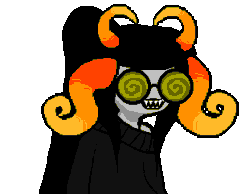

World: Alternia
Name: Erenyx Erixck (Try saying that 3 times fast)
Age: 8 sweeps
Theme/Story: Since her hatching, Erenyx has been very intelligent. Unfortunately, she’s also batshit crazy. Erenyx gives off an aura of “not quite there”, often randomly staring off into the distance and generally acting weird. She’s very into hypnosis and mind control, trying to command lower blooded trolls with varying methods and success.
Local Mod With Psychotic Symptoms Here: Please Stop Making Characters Whose Entire Gimmick Is “Not Being All There.” I hope this doesn’t come off as rude, but I want to teach you how to be a stronger writer. It’s not as scary or edgy as you think it is and it is 100% of the time more of a stressor for the person who has the condition than for anyone else.
People who are most often stigmatized with the “““batshit crazy”““ label don’t want to harm others and experience significantly higher rates of violence directed towards than the general population because of stereotypes like these! Staring off into the distance and “acting weird” aren’t villainous traits. They’re just how people are sometimes. The “crazy genius” is a strung out trope that’s just shorthand so you can get away with not writing character motivation! We’re gonna dissect your girl like a frog specimen and take out her tender Character Traits to build her back better. Bionic frog.
So to give you a stronger starting base here: If you want a troll to be a bad person, make them a bad person. It’s so much more interesting than them being randomly “crazy” and wacky. Make them malicious, and not because they’re ~not all there~. We’re gonna call New “Bionic Frog” Erenyx a bastard because she thinks she’s better than other people. She was born with strong psionics and she thinks that means she’s a cut above the rest, she thinks they should respect her and like her, and that’s why she wants to control others.
(Cosigned as another mod with psychotic symptoms like… it’s not a great look. Also: Everyone on Alternia is terrible for the most part. It was DESIGNED that way in-universe. It’s a planet of hormonal teenagers who are encouraged to murder their friends and neighbors for kicks. You don’t need a “batshit crazy” smokescreen to just write a terrible fantroll. Vriska already exists, and she doesn’t have anything like that.)
Goals: Due to her, let’s say, interesting personality, Erenyx has no friends. So, she reasons, why not hypnotize lowbloods to become her friends?
(I thiiiiink you misread my section on Goals: These are for you and us, not your fantroll’s ambitions (though nice information to have). I’m going to do this as a general review in lieu of anything specific.)
Strife Specibus: Yoyokind. It’s got a swirly pattern and spikes, naturally.
Fetch Modus: I never bother to think these up, it’s more trouble than it’s worth honestly.
(Lowkey agree with you there- I’m horrendous with these. I do think something to help flesh out this spiral motif might be fun? Impressionism, maybe? Some late-Picasso looking art and she’s gotta find the items in it?)
She could also have to solve a maze or labyrinth to get out. Or you could go with something that plays on the Cobra angle and do a snake charmer joke with her playing a pungi.
Blood Color: Gold
Symbol: Actually, I haven’t decided yet. I don’t know why, I just never get round to it.

You could probably rip a symmetric chunk for a pattern like this and have a pretty good gold symbol on your hands.
Handle: mesmerisingOptics [MO]
Quirk: Undecided
If she loves to seem purposefully confusing, you could mix up her words. Organize her sentences in a way that people usually don’t. The best example I can think of this is… I used to follow this RP blog a while back, amusedmuralist, and the way sentences are structured here is what I’m thinking. “Waste your lowly selves not the time allotted you.”
A generally ‘better than thou’ attitude and insults/put downs can go a long way, too.
Special Abilities: Various methods of hypnosis, most of which aren’t very good.
Lusus/Guardian: Cobra Lusus
I do like this a Lot but what about . Kaa. She could face the common troll problem of having a lusus that needs to eat other trolls, and she needs to trap them to feed her snakemom before her snakemom gets hungry and turns on her!
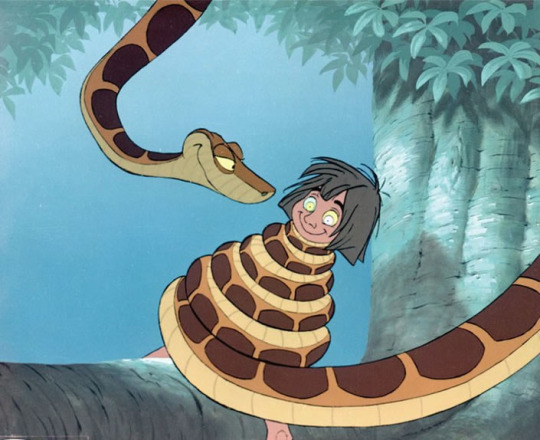
Personality: As stated above, she’s not exactly the most sane troll on the block. Likes to dish out weird threats to innocent passerby and giggle to herself for no reason. Likes spirals.
(This is barely even window dressing on a personality- you’ve made her theoretical, stereotypical mental illness her whole character. You’re overcommitting to a pretty bad gimmick, to be frank.)
(To quote the EZ Gold Signs: “Gold Signs are interested in a wide variety of topics, so they tend to be Jacks-of-all-trade, and can have trouble dedicating themselves to just a single hobby or career. They have a tendency to be high-energy, and can stress people out, including themselves.” This may be a good place to start for a character like this.)
And as I’ve said above, she believes she’s a cut above the rest. She could be a little on the cruel or at least inconsiderate side, a better-than-you type. She could look down on other blood colors and the like. Another gold fact from the EZ is that golds love The Hustle, they like making bank. You could play on a manipulation and control angle and instead of relying on a bad mental illness stereotype, make her an extortionist playing mental health professional? Come to her Hypnosis Clinic, she’ll definitely help you get a good night’s sleep/work through your trauma/cut that chalk eating habit! [Fails to brainwash you]
Interests: Hypnosis, obviously, and other methods of controlling people. Spirals, swirls, other similar things.
(You say Spirals and my first thought is early game Uzumaki. Maybe she has an interest in strange art? Really underground, indie shit that the Highbloods would NEVER see as equal to their epic sculptures and Clowns and stuff.)
Actually, I want to step a layer deeper here. What are spirals traditionally associated with in homestuck? C h e r u b s. And what is there evidence of on Alternia? Giant Snake (Cherub) Corpses. And given that the purples worship the merciful messiahs, I’d be unsurprised if spirals actually featured rather heavily in Clown Church Religion. Erenyx could have an interest in art history on top of an interest in modern perplexing imagery. She could be interested in finding the deeper meanings. She could think that she, in all her GENIUS WISDOM, understands this art and the meaning behind it better than anyone else and that she’s unlocked some hidden truth that means she deserves to be in charge.
It could also be a sparking point for her interest in hypnosis- maybe her psionics don’t actually lend themselves well to mindcontrol, but she’s trying to jack into whatever force allows purplebloods to Chucklevoodoo.
Lunar Sway: See symbol.
She’s a prospitan if I’ve ever seen one.
Title: See lunar sway.
(I think if hypnosis is her game, she’s probably a Heart/Mind inversion player. Actively messing with people’s brains, passively messing with their souls and identities.)
Yeah, cheesy as it is, I’d rule her as thief of mind. Or witch. One of those.
And design corner time:

Hair: I cannot believe you gave me a spiral character and didn’t give her SWIRLS. I had to just embiggen the hair a little more. Big hair on alternia is associated with the Condesce and thus power, so having a big spirally mess of it? Screams Better Than You.
Face: I adjusted her mouth’s position mildly and changed the glasses to cherub colors as a reference to that cherub comment I made up there, but you could change them out for any appropriate themeatic colors- she didn’t have any Accents before!
Outfit: I changed her outline and sweater color to go for something lighter, so the hair would stand out from it better. I added a conceptual symbol for her! Golds don’t wear patterns, so her socks are solid yellow now. I also fixed up her shoes by bringing in tavros’ sandals to edit. You don’t need to draw out individual toes on a sprite form wearing shoes, or else the area gets visually complicated!
Other than that I love this design a lot.
#goldblood#submission#erenyx erixck#erenyx#erixck#review#sa review#redesign#buttercup-n-stuff#cd review
8 notes
·
View notes
Text
BLOG
WANNA BE TRENDY? Here are five hot creative concepts that’ll suit your photography.
Hello everyone and welcome to my second blog post! If you’re reading for the first time, then you’re in the right place! Today I will be elaborating on five trendy concepts that are popping in the photography world.
From my experience, the most trendy thing is to constantly be original. Everybody wants their own ideas and everyone wants to stick out. But sometimes following certain popular concepts can be beneficial for your work! I’ve honestly suffered from constantly wanting to be original myself. At times I’ve stressed so hard to ignore trends that my work has later suffered. Don’t be the old me, and be a kick-ass artist like you already are honey. HERE ARE FIVE TRENDY CONCEPTS FOR YOUR OWN PHOTOGRAPHY.
1. THRIFT SHOPPING (THRIFTING)
One popping trend for the “millennials” is to go thrift shopping. Honestly, I absolutely don’t see one single bad thing about this trend! I personally have a shopping addiction, and thrifting is a gift from the heart for someone else. Or, it’s a place where people drop their old junk for newer future junk! Anyways, thrifting for your photo shoots is what the mighty Paris Hilton would say “that’s hot.” You can always find hot trendy style at any thrift shop but it depends on how dedicated you are yourself. I usually go through every single shirt until one catches my eye. These diamonds in the ruff of clothes can set you apart from other photographers. Pro tip, make sure your clothes suit well with your certain poses and scenes. If not, your photography could look off-putting.

2. CHEAP PROPS
This isn’t just a trend, it’s a practice for the starving artist for raw imagery SUCCESS. Most of all successful photographers use props to either tell a story or for visual aesthetic reasonings. I totally recommend my readers to take advantage of the Dollar Tree. It’s a lovely store because everything is a DOLLAR, legit a dollar! You could buy streamers, glitter, prop toys, bubbles, string lights, and any cutout design cloths! These spectacular cloths could give you a texture if you place it over the camera's lens. After you get the cloth, your job is to find that certain originality in your work. With all of that, It’ll make your photography rawly aesthetic. The beautiful thing about dollar tree is that it’s EVERYWHERE in the United States. If you’re not around a God-given dollar tree, please take some time out of your busy schedule and find the nearest cheapest store. Trust me you won’t regret it and your work will thank you too.

3. ANIMALS
I can’t legitimately stress enough about how adorable animals are. I love animals, you love animals, WE ALL LOVE ANIMALS! I’ve noticed, especially recently that artists are using animals as a gateway for their creativity. I have no regulation why animals are so trendy in the industry. Possibly because of how boujee an individual can look. Imagine this, a girl in the forest with a parakeet on her topless shoulder. Isn’t that just beautifully powerful without even relying on a filter? I would 1000% say yes! Everyone should at least try once collaborating an animal with their models. You never know what raw images you can produce.

Vogue.com
4. NATURAL SUNLIGHT
Don’t get me wrong, I love shooting in a studio with planned out lighting. But the raw texture of natural lighting can be visually breathtaking. This is why shooting in this particular lighting is becoming more trendy once again! The sun creates intriguing shadows over models that other lighting structures cannot develop so effortlessly. If you plan it far enough ahead of time, you can find mouth dropping locations. It’s just mind-blowing how simple lighting and a natural location can tell the story of a picture so amazingly. I would highly recommend capturing the sun at its two golden hours. When the sun is rising or setting, you can get this wonderful combination of orange, yellow, red, pink, or blue over you model and scene! You just gotta take that extra step to get your ass out of bed and capture that moment forever.

5. SHOOTING WITH FILM
Lastly, shooting with a film camera can be trendy and raw at the same time! I personally love shooting with film because of how colorfully expressive the pictures can be. This reoccurring trend makes so much sense because shooting with film is a completely another perspective from DSLR’S. You don’t get the option to take 18,000 pictures of the same subject. With film, you only get a select few tries before you run out! DON’T FORGET film can be sooooooo expensive and you have to pay to get it developed. Sometimes the wait can be a few days but isn’t the waiting the most fun part? Haha It’s definitely a field I would highly recommend a photographer branch into. I personally feel photographers should indulge more in films not for just the trend, but for the overall respect for the cameras roots. We wouldn’t be here today without film. Side note, if you don’t have the extra cash for a film camera. You should download the app called “HUJI!” The app is stylized as a film camera. It is a form of filter sadly but it’s a free digital option!

Stay tuned for next time! I hope everybody enjoyed this blog post because your work will thank you for it. I hope you enjoyed looking at my original raw photos, so please share and like! :)
Have a rawtastic day,
Cj
#blog#blogger#photography blog#art#fashion#amature#tips#like#phot#photography#photooftheday#photoshoot#raw#no edit#follow#vesco#vescocam#writing#new blog#raw picture#picture#animals#film#film photography#photographer#props#prop#thrift#vintage#thrifting
13 notes
·
View notes
Note
Dude do you have any tips for writing fight scenes using the lions because I am utterly blanking, I have no idea how to write a fight scene
For the most part, Iwrite battles that involve the lions the same way I write battles onfoot, so I’m going to start with some general tips and then give afew pointers for the lions specifically at the end.
1)Establish the stakes and the odds.
Beforeyou even start writing the battle, know the context. Know why itmatters. In visual media—film, TV, comics—you can get away withmindless action if it’s pretty enough. With writing, you don’thave that advantage. Some people have a talent for vivid actionscenes, so they can come close (see Brandon Sanderson), but noteveryone can manage it.
The good news? You can have anaction-heavy story without relying entirely on the imagery. The keyis to make each action scene count.
First, establish the stakes. Why dothe characters need to fight? Why can’t they employ any otherstrategy? What do they lose if they fail or have to pull out? The mostimportant thing about writing fights is to make us care about theoutcome.
Second, consider the odds. Ifvictory is a foregone conclusions, do you really need to show thebattle? If you do, it should be brief. Fights where your heroes arethe underdogs are generally more interesting. You can, of course, setup a fight that shouldbe an easy win and have something go wrong. In fact, I encourage youto do so. Which brings us to
2)Battles should be dynamic, both in the details and on a larger scale.
You’re probably already thinkingabout how to make the actual fight interesting, but before you get tothat, think about the big picture. You set up a scenario, but thenwhat? Do the two sides just show up, trade bullets/lasers/punches,and then one side wins?
That works sometimes, especially insmall clashes with relatively unimportant enemies. But with biggerbattles or battles that involve a major antagonist, you’re going towant to do more. Havereinforcements show up, have the villain try a risky gambit. Have theheroes switch to adesperate Plan B (or Plan M.) Let the heroes defeat the enemy, onlyfor another enemy to show up.
I like to look at my battles instages. Minor battles typically only have one stage. Major but notclimactic battles might have two or three stages. Climactic battleshave a minimum of three, sometimes many more. For example:
Stage 1: Heroes are gatheringinformation in preparation for a battleStage 2: The enemiesdiscover the heroes, leading to a frantic battle as the heroes try toretreat/fortify their positionStage 3: Heroes formulate a newplan and enact itStage 4: One of the heroes isseparated from the team, maybe injured, and suddenly is in a desperate fight for their lifeStage 5: Heroes areabout to accomplish their goal when the villains launch a secondaryattack, forcing them to adapt to the new challengeAnd so on
If you’re just throwing in alittle bit of action and don’t want to do a whole big battle, maybeyou only include stage 3. For a little bit longer battle, you coulddo stages 1-3, or maybe stages 3 and 5. Including all five stageswould make it longer still, and as you write you might find otherchallenges to throw at the characters.
Another way to make things dynamicis to have the battle happen on multiple fronts and to jump back andforth between them. Short scenes ending in min-cliffhangers keep thetempo quick and the tension high. It might take some practice tojuggle multiple fronts, so start small—maybe pick two people, onefrom each front, to focus on and jump back and forth. Reallylarge-scale battles might have half a dozen fronts or more, and youmight rotate among the POV characters present at each front, butthat’s something to work your way up to. (Also, outlines reallyhelp for juggling lots of simultaneous action.)
3) Don’t giveus a blow-by-blow.
At least, not all the time. There are moments where blow-by-blow canbe used to great effect, but if you use it too much, it’ll justslow you down. Think of it like slow mo in a movie—it can make adramatic hit stand out, but an entire fight shown in slow mo probablywouldn’t work. Use them sparingly--for the “Oh, shit, something bad is about to happen” moments or the “Hell yeah!” cathartic shots.
Instead, you want to capture the flowof battle. Use short, vivid images; let us know whohas the upper hand, who’s struggling, whether or not people aretaking injuries/ships are taking damage. Don’t linger on thescenery, but show us how the battle is progressing through space.
4)It’s not always about the fighting.
I write a lot of big, action-heavystories, but when you look at it, there’s not nearly as muchfighting as you might expect. There are other ways to up the tensionand energy that aren’t necessarily battles—you can doinfiltration, arguments, suspense, ect.And even when you do have a battle, you can (and should!) break it upwith conversations, strategy discussions, momentary lulls in thefighting that allow for reflection or sudden understanding. Someonecan get wounded/their ship can be knocked out and they have towithdraw from the battle momentarily.
It’s hard to give specificsuggestions here, because so much of this point depends on thesituation you’ve set up (in a specific scene or across the wholestory.) The important thing to remember is that for the most part,and doubly so in fanfic, people are reading for the characters.Action is great, but don’t lose sight of the people in the middleof the battle. What do they want? How do they feel?
You’ll have to be concise withwhatever you do sprinkle in so you don’t slow the pacing down toomuch, but dialogue, internal monologue, and other breaks from pureadrenaline-fueled fight will ultimately heighten the drama.
Lion-specifictips
The thing about Voltron is…Voltron itself isridiculously overpowered. It works in a cartoon because you get somepretty action sequences and some nice explosions, but in fic, thatgets boring fast. But you can’t ignore that it exists, because thepaladins aren’t going to make things harder than they need to be.Which means if you want to keep things interesting, you either needto create a challenge that even Voltron will struggle with, or youneed to come up with a legitimate reason for them not to formVoltron. Maybe that means giving the team two targets, maybe it meansone of the paladins isn’t in their lion for whatever reason.
Aside from the Voltron conundrum,the main difference between fighting on the ground and fighting inthe air is the kinds of risk the characters are faced with and thekind of challenges you can throw at them. On the ground, injury is avery real danger, and it’s comparatively easy to split the group upor to give them tasks they have to do (hacking, leading prisoners tosafety, sabotaging a weapon…)
In the lions, you’re one stepremoved from all that. It’s possible for the paladins to get hurtstill, but more often the risk is that the lions will get hit badenough to impact their performance. This could mean the shields aredown, the comms are jammed, the stabilizers aren’t working… Or itcould mean the lion is out of commission entirely. Whatever the case,the paladin can (and should!) react to this, though it might meanthey won’t be able to focus on the battle as much.
They can also still have differenttasks, but they might lookdifferent. The lions are mostly only useful for transport or forfighting, so unless its something that can be done remotely, anyspecific tasks are probably going to require some of the paladins tostrike out on foot.
The best thing about writinglion-based fights is getting to be a little more over the top thanusual. The lions are tough, and they have some badass weapons—so goahead and have Yellow headbutt a Galra cruiser. Let Red melt throughan ion cannon with her fire breath. Invent new abilities and play aroundwith them. The lions aren’t invincible, but they are incrediblytough.
Which brings up another point: in aground battle, the paladins’ lives are basically always on theline. The same mightbe true inside the lions, but not to the same degree. So if they’rein the lions, you need to put someone or something else at risk. Aplanet, a base… Or something more abstract. Maybe this fight is allabout buying time so some allies can enact a plan to sabotage aweapon or something. Something so that failure is a real possibilityand has real consequences.
I’m sure there’s a lot more to be said about writing fight scenes, but hopefully that helps you get started!
70 notes
·
View notes
Text
Local SEO Strategy Guide: How to Rank Where It Counts via @webceonews
Who exactly needs optimization for local search? At first glance, it’s obviously those who want customers to walk through their doors physically. But those, who conduct business without meeting people face to face, are still going to need local SEO as long as there’s a benefit and opportunity to attract customers from a specific area (whether it’s a single town or an entire country). Many businesses fool themselves into thinking that, because their products or services are available to a worldwide market, there’s no benefit in specifically doing well in the region where they are located. This is often a mistake. At its core, local SEO is about two things:
Placing your site in the most visible spots in local search.
Gaining your target audience’s trust.
And both are perfectly within your reach. So, is your mind ready for some work? Have you armed yourself with high-quality SEO tools? Let’s do it, then.
1. Use Local Keywords
Normal search can be described as “find me this thing”. Local search adds an extra component: location. Users tell the search engines “find me this thing in this place”, and all other places are recognized as irrelevant and filtered from the results. What remains? Results that are relevant since they are about that thing in that place. And because websites rely on keywords to be found via search queries, you can imagine that not just any keywords will do. They will need that extra component. Examples of local search-friendly keywords:
Buy bicycle in London
Bicycle store near me
Bicycle store near The Ritz
Closest bicycle store
You can also try to include local jargon in your keywords. It’s a way to localize them without explicitly naming the place. That’s how local keywords are different from normal keywords. What else do you need? A way to pick the best from the lot. There are two major factors.
Search volume: The number of monthly searches by users. The higher this number, the more users you can potentially attract through search engines, so aim as high as you can.
Search intent: A good keyword clearly represents what the users are trying to find. Local keywords are already more specific about that thanks to including a location, but you can increase your chances to attract the users you need by doubling down on details. Compare these two keywords: “buy bicycle in London” and “buy mountain bike in London”. Adding an extra detail signals to potential customers that you have exactly what they want.
Now, with all of the above in mind, all that’s left to do is find the best local keywords for your site. There is a keyword finding tool that can do just that: Keyword Suggestions.

Type your keyword ideas into the bar and press Search. The tool will display information on the keyword you entered and suggest many other potential keywords you could use. It will be up to you to decide which are the best for you.
2. Create Optimized, High-Quality Content
Search engines rank websites based on their overall authority – their reputation, if you will. It’s the sum of all factors that indicate a website’s value to users. However, users rarely think about most of those factors and only focus on a site’s content. That’s what they see most of the time, after all. So the question is: what kind of content is valuable and the most likely to make money?
Useful: It must offer users solutions to their problems.
Informative: It must provide as much information as users might need.
Convincing: It must be able to convince users to become your customers.
User-friendly: It must be simple to view and use.
SEO-friendly: It must be optimized to rank in search engines.
Unique: Every page on your site must be one of a kind and not copied from anywhere – not from another site, and not from your own.
You can find all these traits in content that ranks on Google’s first page. The closer it is to the coveted position #1, the more apparent these traits become. There is no standard to create high-quality content – making a really successful piece often requires inspiration and ingenuity. But there are general tips for SEOing your content that everyone can use. Help search engines and users understand what your content is about. Put your keywords in these places on your site’s pages:
URLs. Make your URLs short and readable.
Page title. It must be unique for every page.
Meta description. It, too, must be unique for every page.
H1-H4 headings. Don’t just use a slogan without keywords as an H1 tag.
Image titles, captions, and ALT attributes.
Other text.
If there are poorly optimized pages on your site, find them with the On-Site Issues Overview tool.
3. Use Eye-Catching Visuals
Visual information is really good at getting the point across. In fact, no other type of information comes close. That’s why, if you are trying to sell something, graphics and videos are essential for you. They will make your website look alive and your business more presentable. What is especially good for local SEO?
Pull out all the stops and show your customers everything you’ve got: The building where your workplace is located, the surrounding area, what your workplace looks like inside, your products and/or services, your employees, even your customers (with their consent). Make your users want to visit the place they see on the screen.
360° photos: A tripod may cost you a bit, but a beautiful panoramic shot is priceless. It’s also fun to interact with, so that’s a bonus point for the user experience (UX) on your site.
Remember the part about making your site look alive? That’s literally what the word “animation” means.
Videos. Sound, imagery, and text make the most powerful combination existing on the web, and nothing has topped it so far.
Got a bit of interesting knowledge that’s related to your line of work and would be better digested when spliced with some pictures? That’s the recipe for an infographic. It will have an even greater effect on users if it’s unique and no other infographic talks about the same topic.
Charts and diagrams: Confidence is born from success. Don’t be afraid to show that you know what you are doing! If you can tell a story about your success, it might be possible to show it in a visual form – for example, how much your sales have increased or how many customers you have served over the years. Just be careful not to brag too much.
And if you enable an option to share your visuals in social media, users will be all too happy. Lastly, there’s a way to make your images even more useful in terms of local SEO: geotagging. It means adding GPS information to images, making it easier for search engines to associate them with specific locations. Usually, modern cameras (including phone cameras) do it automatically, but if your photos somehow weren’t geotagged, you can do it manually with a free online service.
4. Optimize for Multilingual SEO
If you plan to be really successful, I doubt you will sit on the same spot your entire life. You will want to expand, claim new ground, gain even more customers from new places. Eventually, you may even cross borders. And once you build a new HQ in another country, your local SEO will crash right into the language barrier. That’s where international SEO takes the stage! It isn’t as simple as translating all your content into a foreign language. There are many more steps to take, but here’s a full list of them – hopefully before you need them.
Choose the Most Optimal URL Structure
Where should you put your international content? You have these options:
Keep it on the same domain.
Purchase a new domain.
Create a subdomain.
For the purposes of international SEO, the best option is to create a subfolder on your existing domain. Like so: https://example.com/de. Why this over the other two? It’s because a new domain and a subdomain will end up competing with your current domain for rankings – definitely not a good thing in SEO. If you use a subfolder instead, it will receive all the domain authority you have already built up until now. Another way to keep translated content on your domain is to use language parameters (e.g., https://example.com/?lang=de), but this isn’t a very SEO-friendly approach. Search engines sometimes have trouble indexing pages with parameters in their URLs.
Use the Hreflang Attribute
Search engines will recognize the language of your content with no problem, but it’s still a good idea to spell it out for them. To do that, use the hreflang attribute in your pages’ HTML code. Like this: <link rel=”alternate” href=”http://example.com/de” hreflang=”de”/> Keep in mind that this attribute tells search engines both the language of your content and the region you are targeting with that page. This is where it gets tricky: you must pick the correct value for the hreflang attribute. For example, the value in our example is “de”, which means German content independent of region, but if you want to target a German-speaking audience in Spain, the value must be “de-ES”. Fortunately, Wikipedia’s got you covered: it has the list of language codes and the list of region codes. Simply pick what suits your situation from one or both of these lists.
Set up a Layout That Doesn’t Conflict with Different Languages
As you know, not all languages write from left to right. If you translate your content into a language that writes in a different way, make sure it still looks good and can be easily read on your site. Otherwise, you will have to change your site’s layout.
Don’t Use Automatic Redirects
You might be tempted to check your users’ IP and automatically redirect them to a translated version of your content. There are two reasons why it’s a bad idea:
Redirects add to page load time, lowering page rankings and hurting UX.
Users might not actually know the language you are giving them, which is even worse for UX.
Just don’t set up such redirects.
Use Only High-Quality Translations Done by a Human
A native-speaking translator beats a machine all day, every day. Don’t be stingy; there’s many a tale about people who embarrassed themselves with a poor choice of words in a foreign language. Invest in high-quality translations done by a person who knows what they are writing about.
Don’t Use Country Flags or Names in Your Language Choice Menus
Here’s another rookie mistake: confusing country flags with the languages they supposedly represent. People migrate all over the planet, often to stay. It’s hard to name a country where they speak only one language. That’s why, when you make a language choice menu on your site, you shouldn’t rely on countries’ names and flags to signify the options. Now if you use the languages’ names instead, there’s no risk of making a mistake. One look at such a list and the person will immediately know what they need to choose.

Allow the Use of Local Currency
This is a good tip for ecommerce site owners: you will acquire more customers this way. The dollar is used worldwide, but people are often more comfortable with their own country’s official currency. Give them an option to pay with it if your payment processor allows this.
Optimize for Local Search Engines
While Google is used everywhere, many countries have their own popular search engines. It’s, therefore, a good idea to research those search engines and figure out how to rank in them. Before you start worrying, know that many of them are powered by bigger and more famous search engines like Google, so this task is a lot easier than it sounds.
Make Sure Your Content Is Culturally Sensitive
Who wants to risk an international incident? No business owner worth their salt, that’s for sure. What is acceptable in one country might not be so in another. When you expand into a new place, you must be aware of its cultural situation and what is considered offensive there. Wherever you are trying to make money, be careful not to step on too many toes.
5. Make Rich Snippets with Structured Data
What’s the best way to make your search results more clickable? Titles, meta descriptions, URLs – these are all good places to start and improve. But the absolute killer way is to turn your results into rich snippets. You know, these guys:

Don’t they look enticing? You can make these for literally any site. All you need to do is schema markup (also known as structured data) and the knowledge about how to use it. There is an in-depth tutorial for that on Schema.org’s official site. What do you normally mark up on a website for a local business?
Address
Telephone number
Opening hours
Review score
Prices
Menu (for the food service industry)
Number of rooms (for hotels)
Number of screens (for movie theaters)
And more. Anything you want to show in your search result, you name it. There are two important things to keep in mind with structured data:
Mark up the information on your web pages correctly. If you don’t, your rich snippets will show your information in the wrong places – for example, your product prices where your telephone number should be.
Validate your pages with Google’s Structured Data Testing Tool. It’s the easiest way to spot any errors you may have made.
6. Gather Positive Reviews
Customer feedback is more powerful than even the prettiest, most clickable ad. Utilize that to come out on top. In fact, if you want to come out on top, that is your only option. But no pressure! Fortunately, as long as you keep your business in top form and provide great service, it will be easy to gather positive customer reviews. If you want to make full use of them, you will want to show what people say about you on your site. Be sure to create a page where your customers can leave their reviews for other users to read. But don’t stop there: take it one step further and display your review score in your rich snippets, too. And how to make your customers leave a review? Just ask them and provide a link to the review form.
7. Create a Google My Business Listing
Another huge help in local SEO is Google My Business – Google’s free tool for managing your appearance in local search. Let’s make this clear: these days, there is no local SEO without Google My Business. If you don’t create a listing there, customers will have so much trouble finding your business that they will probably not bother with you at all. The benefits of using GMB are so enormous that everyone wants to successfully register with them, and disregarding them means to doom your business to obscurity. If you still need more motivation, here’s what you will get for creating a listing on GMB.
Ranking boost in local search.
Google Maps: a spot on the map for every address you occupy.
Local 3-pack: a place in that list with three results under Google Maps.
Knowledge Panel: the large panel with information at the top right side of Google’s first page.
The only potential downside to GMB is the sheer amount of information it displays for you – it can be easy to get lost. But this sort of problem is easily solved with SEO tools, particularly WebCEO’s Google My Business tool. You can use it for these tasks:
Get information on how users interact with your business in search: impressions, site visits, photo views, phone calls. If you have multiple listings, the tool can display this information for all of them at once (whereas Google My Business shows it for only one at a time). Switching between listings is also easier.
Find your local competitors (including the ones without their own websites). The tool sorts your competitors in the list based on their distance from you on Google Maps – something even the actual Google My Business can’t do.
Manage customer reviews. You can even reply to them without leaving WebCEO’s platform.
8. Use Data from Google Analytics and Search Console
Everyone who does SEO has at least heard about Google Analytics and Google Search Console; many are even skilled at using them. And they have a lot of data that will prove useful to a local business. It’s no secret that Google’s services can be hard to navigate, so you should also use SEO tools that can draw Google’s data and present it in a more user-friendly way.
Local Keyword Analysis
Are you aware of every keyword your site is ranking for? Sure, you are optimizing it for a few or a lot, but there may also be other queries that trigger your site to appear in search. If you start using them more actively, it could be your chance to get more traffic than before. Where to Find This Data: The Google Search Queries report is integrated with WebCEO. It’s a good place to find new local keyword ideas since it also shows the queries’ impressions, average positions found by Google searchers globally in the past 30 days and click-through rates.
User Interaction with Your Site
Do users click on your site in search results or do they ignore it? What about how they act once they arrive on your site? Obviously, the more users find you and give you clicks, the more you can earn – that’s the whole point of having a website. You don’t want any problems with this part. Where to Find This Data: Google Search Console -> Performance. Here you can find a chart with your impressions, clicks and click-through rates. You can get even more detailed information in the table under it – for example, checking the CTRs of your individual search results. You will also need information on your bounce rates, which you can check in Google Analytics -> Behavior -> Site Content -> All Pages.
Local Audience Analysis
As a local business, you will want to bring in people from specific places. You will also want them to have certain interests so they will at least consider becoming your customers. Therefore, it would help to know how good your site is at attracting such people. Where to Find This Data: Geo reports in WebCEO.
Traffic by Country: Check how much traffic you get from all over the world, along with bounce and conversion rates.
Traffic by City: Narrow down your traffic to an individual city.
Language of Visitors: See the languages used by your most prolific users.
Another useful report can be found in Google Analytics: Audience -> Interests -> Overview. Divide your site visitors into categories of interests and see how many of them come from your target audience.
Audience’s Journey
How do users come to your site? What pages do they visit? Where do they start, where do they go next and where do they drop off? If you can understand how users browse your site, you’ll be able to influence the course of their journey and direct them to pages where you need more visitors. Where to Find This Data: Google Analytics -> Behavior -> Behavior Flow. Sort user traffic by Acquisition -> Traffic type as shown on the picture below. With this, you can view the users’ journey through your site while highlighting the different sources of traffic.

Use of Your Site’s Search Bar
If you have a search bar, you should know what your users do with it. Their search queries will tell you a lot about what exactly they want to find on your site. You can optimize your pages for these queries or even create new pages if the users are looking for something you don’t have yet. Where to Find This Data: Google Analytics -> Behavior -> Site search.
9. Build Local Links
When one site places a link to another, it tells Google: “These guys have relevant content! It’s valuable to our users!” At least that’s how it is when everyone is playing by the rules. What do you think happens when local resources recognize your business’ site as relevant? Your site receives a ranking boost. Research the sites that share a niche with you – backlinks from there will be the most valuable. You can look up many examples of such sites in the Content Submission tool. What kind of sites should you look for?
Local forums
News portals
Blogs about local events
Other businesses’ sites
Business directories
It’s also a great idea to check your local competitors’ backlinks – their linking domains could be useful to you too. Find those domains with Competitor Backlink Spy.

10. Use Unique NAP(U) Citations
Contact information for a business serves two purposes. It:
Allows potential customers to contact the business.
Can be treated as its unique identifier.
Why is this important? Some businesses have either the same name or the same address as another business. In rare cases, they can have the same phone number. However, it’s next to impossible for any two businesses to share all of the above. You won’t confuse them as long as you have this information. And if you don’t have it? Problems arise. Here’s an example. Let’s say there are two movie theaters with the same name, but in different cities. You have their phone numbers, but you forgot which theater is from where. You are left with one theater name and two numbers. How do you know which one you should call to book a seat? It’s not a very difficult problem, but it’s still a major inconvenience. That’s why NAP(U) or UNAP citations are so important. They include your business’ name, address, phone number and website’s URL address.
Fill out this information on your site.
Fill it out on Google My Business and other business listing sites.
If it happens to change, be sure to change it everywhere!
And while you are at it, here’s an easy way to give your citations an extra oomph: embedding Google Maps with your location on your site.
11. Fix Technical Issues
Can you expect to have a good user experience on your site if it’s barely working? I can’t imagine anyone saying “yes”. Unless it’s suffering from special, funny errors that you couldn’t cause on your site deliberately if you tried. More likely than not, your site errors will be annoying and unsightly. (Although nothing is stopping you from creating a funny 404 page. In fact, it’s encouraged.) Scan your site for errors with the Technical Audit tool and fix everything it finds for you. You can adjust the scanning speed if you have a slow site that might return false-positive errors if the scanning tool goes too fast.

12. Optimize Your Site for Mobile
How big is the mobile web? The way things are going, it’s fairer to say that PCs are competing with mobile devices for online traffic, not the other way around. Still, the two often work in tandem like this: users look up a product on a mobile device and switch to a PC to make a purchase. From this fact alone, I can offer two pieces of advice:
Don’t be too alarmed if bounce rates are high and CTRs are low when examining mobile traffic.
Make your site mobile-friendly so it might convince users to seal the deal right there – without switching to a PC.
Now for achieving mobile-friendliness. There’s quite a lot of work to do, but it all boils down to making your site easy to use on mobile devices. Since you don’t normally make two separate sites for mobile devices and PCs (at least you shouldn’t), your site needs to be optimized for both at the same time. Already a conundrum, don’t you agree? But here are all the necessary steps.
Large, easy-to-read text.
High-quality images with minimum file size.
Mobile responsive design.
Low page load time.
Space between paragraphs of text, links and interactive elements.
You will need to check your progress at some point. That’s when you should test your site with the Mobile Optimization tool.
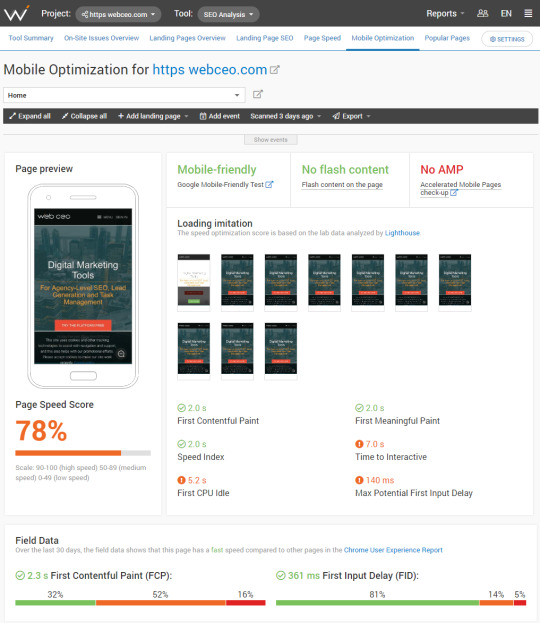
Also, try using your site yourself to make the final judgment. Bonus points if you check your site from several devices with different-sized screens.
Want to Read Steps 13-25?
There’s still a lot more to local SEO. Download the full guide below and get twice the number of SEO tips, methods, and tactics to help your business grow. This guide was made exclusively for WebCEO users. Sign up now and begin 2020 with a winning hand!
https://www.businesscreatorplus.com/local-seo-strategy-guide-how-to-rank-where-it-counts-via-webceonews/
0 notes
Photo

The World in the Eyes of Mike De Leon
A recent study conducted by Michelle A. Pautz, a political science professor at the University of Dayton in the state of Ohio in the United States, proposes that films serve as a strong influencer. Dr. Pautz believes young viewers may be especially open to the influence of movies. She states that “Younger people, particularly teens, are much more likely to be impacted than older adults because they are still developing and shaping their worldviews,” Film is arguably the most accessible form of art to Americans. Watching a movie occupies our senses more than any other form of art, particularly when we experience it at our local Cineplex. Regardless of its content, film has the power to shape perceptions of moviegoers on a range of subjects from love and marriage to the work of government. We can assume that people tend to gravitate more towards film than any other artform is because it can serve as somewhat of an escape to its viewers.
Pop culture is a marriage between culture, art, and media. Though what we can notice in pop culture is that a huge sum of it is largely influenced by film. The cultural impact of films are significantly seen in our lives, from George Lucas’ worldwide phenomenon, Star Wars, to the quotable swoon-worthy quotes of Leonardo DiCaprio in James Cameron’s Titanic. Visibly, films play a pivotal role in our society, heavily affecting the way we think, the way we see and the way we perceive the world around us. In the digital age we live in currently, films are practically universal. Jumping from bulky television sets, to sleek flatscreens, and to the comfort of your phone screen, films can be accessed with a swipe and a tap of your finger. With streaming platforms like Netflix and Amazon Prime, that offer film libraries in a single app, which just goes to show how available film is even to the average Joe.
Film is an artform that is ever evolving, as film is juxtaposed with today’s scientific and technological advancements. Given that as technology paves the way with newer more cutting edge devices, software and etc, this enables films to be better, smarter and more innovative. Although films are not built around such external factors but rather, it is built around the artists behind it, the storytellers and the movers that come up with what you see on screen. Like an artist to a canvass, a director is the heartbeat of the film. Filmmaking is a tedious process that is comprised of many intricate steps. However, many directors take matters into their own hands often controlling anything they can to ensure that whatever they envisioned for the film is executed properly. In many cases, the directors are also the writers of the film with filmmakers such as Guillermo Del Toro and James Cameron. Regardless of this, there are many ways to go about filmmaking, one different than the other. The story in which a film follows is essential but what truly decides a films fate is how well that idea is embodied and visualized.
With that, we can say that the directors are indeed the auteur of the film, or its author. Here we can incorporate the auteur theory, this basically means that the directors are the hands that shape the film, the one whose eyes we see through. This theory expresses that the distinct flair and style of the director is what makes a film stand out from the rest. The theory itself expresses that a “bad” director can also have the ability to make great films whereas a good, esteemed director is also fully capable of making bad films. In a sense, a good film can only be made when a director believes in his own vision, that he can create a world built on ideas in his thoughts. And that a film is likely to fail if one relies on the script too much or other supportive elements other than his uniqueness and style.
The auteur theory bestows directors with the ability to have as much fun with the film as they want to. Pioneers of this theory were Alfred Hitchcock, Francois Truffaut, Satyajit Ray, Akira Kurosawa, Jean Renoir, they were one of the few true Auteurs who believed in using their own style of filmmaking. They had hoped that by establishing their own artstyle, or by marching to the beat of their own drum, so to say, they are able to create their own signature on film, imprinting their unique sense of film. Generally, directors breathe life into the film as they are the true creators of the film, and that though the end product is however a unified effort of every single individual in the movie. The cooperation and culmination of all those people are the backbone of the film’s success, and that the director is what pushes and lifts them towards the right path. The auteur theory is not only applicable in film but rather in life as a whole, we should not be afraid to break the mold, that we should break free of stereotypes that life dull and uniform. Difference is what makes us beautiful similar to that of films, such styles are what catapulted the likes of Stephen Spielberg, Pixar, Disney, and A24.
Although, many directors use their own distinct style in a more unconventional way. Portraying ideas in a way that has not been seen before, their ingenuity as filmmakers leaning more on the weird, offbeat side of cinema. In 1990, Tim Burton directed the Fantasy/Horror film Beetlejuice, starring Winona Ryder, Jack Nicholson and Alec Baldwin. The film made its debut on March 30, 1998, which is astoundingly over 30 years go. To this day we can still see the cultural impact its made in pop culture today. As an auteur, Tim Burton creates films that tackle dark, peculiar themes but executing it in quirky, lighthearted ways with the use of stop motion at times but mostly with the use of song. His take on horror films are what made him one of the prominent auteurs younger people have grown to love.
On the other hand, we have directors whose peculiarity is nothing short of shocking and thought provoking, like Danish filmmaker Lars Von Trier. His works are rather significantly more risque than than that of Burton, his works are no stranger to controversy and backlash with the outlandish use of sex and violence. However, his films are remarkably intriguing and complex. His two part cinematic masterpiece, called Nymphomaniac was a bold-faced interpretation of sex addiction and the grim reality of sex. To the untrained eye, his works can be seen as softcore pornography, however such scenes help exude the emotion of the scene. This boldness and willingness to take risks, is rather polarizing however the nerve of his films are what makes him a true auteur. In retrospect, we can see that directors have many different interpretations of film, ones lighter than the others. However, this goes to show that directors wish to convey different messages with the films they make. They themselves use the platform they have and their film expertise to evoke a narrative or an issue they want to shed light on and delve into deeper for the public to see and to educate themselves on.
In 2000, Lars Von Trier directed the danish crime/drama musical titled, Dancer in the Dark starring icelandic singer, Bjork. The film centers on the injustices faced by a single mother and her impending blindness whose fate is ultimately doomed. This captivating film, is an expose on the lives and hardships of single mothers, poverty, being a blue collar worker, and being blind. Tough pill to swallow critics deem it, however the provocative themes helped establish the film to the mainstream. Such films like these, that fight and speak for many causes are what helps gravitate viewers towards it, it helps them sympathize with the character thus establishing a connection with a film.
However, in the Philippines, we also have our own auteurs that are rather peculiar in nature. Those that take unorthodox approaches with regard to filmmaking like Mike De Leon. A renowned and esteemed director, writer, and cinematographer who was under the stewardship of national artist Lino Brocka working as a cinematographer in 1975’s Maynila Sa Kuko ng Liwanag. A native to the Philippines, De Leon’s humble roots started in May 24, 1947 in Pineda, Pasig City. His budding creativity took him to places even majoring in Art History in the University of Heidelberg in Germany. Working under Brocka, he had opted to branch out as he started to make a name for himself. Itim (1976) was De Leon’s first full length feature film that won him esteemed accolades at prestigious international festivals like the 1978 Asian Film Festival in Sydney, Australia. Itim was also deemed one of the “10 of the most outstanding films of the decade from 1970-1979” by the Philippine Urian Awards. De Leon’s first feature film, is one where technical prowess and abilities trumps almost everything else. The film mixes Catholic imagery with tinges of the supernatural to create an atmosphere that forms the backdrop to that is hallucination-inducing and overall, a haunting experience. Overall the narrative is a film splashed with elements of fantasy with more realistic, down-to-earth social concerns.
In the film Itim, De Leon took inspiration from superstition, spirituality and religion that are widespread in Philippine culture, such themes were especially demonstrated successfully. De Leon drew inspiration from our culture, highlighting parts of which that are not especially alluring to viewers. What sets Mike De Leon apart from other filmmakers is that his films truly speak for something, he wanted to show that sometimes the truth is not as glamorous as people make it out to be, showing that often times, the truth is cold and harsh. Earlier this year, he released a short film on video sharing platform Vimeo, called “Kangkungan”. Rooting from the Filipino expression “Pupulutin nalang sa kangkungan”, De Leon made this a metaphor for the extra judicial killings under the Duterte regime. Some viewers believe that it comes from the practice of disposing of summary killings in Kangkungans. It goes in depth in Duterte’s bloodbath and his so-called war on drugs. It even talks of the arrest of Senator Leila De lima, and the removal of Maria Lourdes Sereno as chief justice. In the film the quote “Itinatapon ng taong ito ang Pilipinas sa kangkungan,” referring to how our presidents leadership is running our country to the ground as the film depicts.
It is evident that De Leon’s films are very heavily politically driven. He is known for creating films that discuss patriarchy, discrimination, misogyny and fascism. In 2018, he directed and produced noire crime drama film, Citizen Jake starring journalist Atom Araullo. Similar to “Kangkungan”. Citizen Jake illustrated and exposed the sociopolitical landscape here in the Philippines and the people behind our administration today. He even poked fun at corruption here in the Philippines by bringing up figures such as Jinggoy Estrada, and Bong Revilla. Even bringing up the Marcoses and Manny Pacquiao. All throughout his films, we can gather that De Leon has a penchant for gore, violence and overall disturbing imagery.
One of his most prominent work like that of 1982’s Batch 81’ that highlights how detrimental and toxic culture of fraternities that thrive off of violence and brainwashing. In the film, we can see that the film is very anti-woman, which in essence, captures the misogyny and discrimination against women present in that era. The females in the film were mere plot devices, nothing more nothing less. The oppression against women especially notable with the dynamic of the protagonist, Sid and his girlfriend. However, a topic that is greatly tackled in the film is hazing. At this day and age, similar problems and issues persist in society. With the deaths of Atio Castillo and the exposure of hazing in the Philippine Military Academy. Such films are relevant and pertinent to the issues we face in society. This shows kind of a harsh reality given that the film was released almost 30 years ago, society today still remains the same, societal problems like hazing and misogyny are alive and well even to this day, which goes to show how little we have progressed as people.
It should be noted that Batch 81’ was a reflection of the Marcos regime at the time. The film centers on Sid Lucero, an aspiring neophyte for the fraternity Alpha Kappa Omega, better known as AKO. Throughout his hazing, he is subject to copious amounts of humiliation and psychological abuse yet his seniors are adamant this is a right of passage for every neophyte. Some suggest that the protagonist, Sid, is a metaphor for society then which shows the great deals of torment we had to endure under the rule of Ferdinand Marcos. Batch 81’ was somewhat of a silent protest at an age where Marcos was in control of all, if not most forms of media. As an auteur, De Leon’s signature as a filmmaker is his knack for political films that speak to people and fight for a cause, which directors should aspire to be. What good would films be if they did not teach us lessons we need to learn?
However, with his penchant for politically themed films, we can see how experimental he came to be in the years to follow. In particular his work in Kakabakaba ka ba? Which is a musical, romantic comedy focused on one man’s unfortunate twist of fate when he is untangled in the world of drugs. In the film, Johnny is used as somewhat of a mule to transport raw opium unknowingly, he is chased by Japanese and Chinese gangs that wish to possess the opium he smuggled in the Philippines without his knowledge. Ultimately, the film is a reflection of how our society and economy is held at a chokehold by foreign forces such as the Chinese. This is especially prevalent given the number of Chinese occupants are rapidly increasing in the nation’s capital, as we slowly become a slave at the land our country owns. It also touches up on the subject of the church and how corrupt it can be regardless of the irony.
Both films are similar in nature because both speak for a cause close to the Filipino’s heart. Other filmmakers can only aspire to be like Mike De Leon, his determination to use his platform as a filmmaker to create films that speak not only for the problems of our society but what we deserve as people of our nation. We can admire him for peacefully protesting and airing out his bad blood with the government through art, because through this he is able to reach and educate more people about prevalent issues in society. Although what is truly refreshing is a director that truly pushes the envelope in filmmaking. One who is driven by his own principles, looking at film more than just entertainment but rather someone who uses this platform to change the culture of cinema, to cultivate a smarter audience that is able to instill the values the film exudes.
In an age where modern tyrants like President Duterte run the country like a child to his toys, we should be able to educate ourselves in any way we can, whether it be from the news, from newspaper or through film. We must take it upon ourselves to foster a community that is socially aware of the reality of our nation today and the crises we face as people. In an interview with ANC, Mike De Leon was asked about his inspirations about his recent and provocative short film “Kangkungan”, he replied saying, “It was anger, frustration, disgust and despair.” That drove him to create such thought provoking films that truly speak to people. As we face a similar fate to that of the time of martial law, filmmakers like Mike De Leon are our beacon of light, those who are truly capable of sparking a change; a true mark of an auteur.
However, some directors are led to believe that cinema is dying. Realistically, people are unable to shell-out the time and money to visit a local cinema, and often times these cinemas show the same run-of-the-mill teen heartthrob-led film or the latest Vice Ganda slapstick film. With that De Leon opts to use platforms like Vimeo knowing well enough that people simply cannot afford the luxury to visit the cinema these days. A characteristic of a genuine auteur is his ability to mold himself with the ever-changing culture of film and the needs of people at this day and age, De Leon is an exemplary sign that there truly are many auteurs in Philippine cinema today, but are rather just outshined by people who see cinema as a money making machine than as a visceral, powerful medium of art.
The overall effectiveness of film is truly a feat, it is able to convince and persuade viewers with the notions and concepts it embodies. However, with great power comes great responsibility. In times where the world was in ruins, and people were struggling to stay afloat while dictators run the world to ashes, film was used as a vessel to spread out false and discriminatory propaganda. We can see that the power of film can be used for purposes that are not for the betterment of society. In an age where film is as easy as reaching into your pocket, films should not only be for the entertainment but for the purpose of education and enlightenment. A good director can execute their idea to the best of their abilities, with topnotch cinematography, impeccable editing, compound script but what separates bad films from good is the very idea behind it. Directors should be able to fight something, they should be able to create awe inspiring films that capture the thoughts not the eyes of the audience because after all, good films are a mix of mind and heart.
0 notes
Photo

New Post has been published on https://simplemlmsponsoring.com/attraction-marketing-formula/attraction-marketing/how-to-give-your-customers-all-the-feels/
How to Give Your Customers *ALL* the Feels
I’m going to paint a picture for you, Bob Ross-style – but with more manageable hair.
You’re running a successful business and you LOVE it… most days. You’ve consumed as much data as possible – ravishing every business book, blog, or podcast you can get your hands on. But, even though you’re in demand, you still feel like you haven’t quite pulled it together. You haven’t reached your full potential or accomplished what you know you’re capable of.
I. HAVE. BEEN. THERE. Ooooooh, have I!
This may not be what you *want* to hear, but it’s true – there are some things you just have to learn on the fly, waist-deep in it, figure-it-out-as-you-go style. You can read all the books you want (and you absolutely SHOULD take advantage of any and all resources that speak to you), but at the end of the day, there are certain things you’ll just need to experience firsthand. And, some of these things will be missteps.
I’ll tell you a story. This is living proof that there are situations out there that, yes, you could prepare for, but don’t necessarily know that you *need* to prepare for.
Here goes… When I first moved to Naples, Italy, the kiss on the cheek as a greeting or farewell was no stranger to me. Living in Hawaii, this was pretty commonplace. BUT – and this is a *big* but – it turns out that in Italy, they begin their cheek-kissing on the right. I didn’t know this, and came dangerously close to full-on lip-locking my brand new landlord. Talk about EMBARRASSING.
The lesson here? Sometimes you don’t find out that you’re not in-the-know until you’re centimeters away from your landlord’s mouth. Or, more aptly, you don’t even realize that you don’t know something until it becomes abundantly clear that you, my friend, just screwed some stuff up.
This feeling manifests itself in a lot of different situations – business, parenting, socializing. And it’s OKAY. It really is. I like to say, “Some of us learn by doing, but ALL of us learn by doing something really stupid.”
Throughout the creation and growth of my own brand, I’ve developed some beloved programs to help other entrepreneurs build and scale their brands. More than three years ago, I launched the Brand Personality Quiz, then created Brand New Brand (my program for entrepreneurs who are just getting started – the dreamers and do-ers who are at less than $100K in revenue, and who want the step-by-step process that I use with my one-on-one clients). Finally…my third baby – and yes, I refer to my programs as my children – is named Brandfluency… and she’s a beaut!
See, you can know your brand archetype and rattle off the logistical to-dos involved in establishing a business, but unless you know your brand inside and out, you’ll always miss the mark. In fact, it’s been scientifically proven (via MRI neuro-imagery) that consumers primarily rely on their emotions when evaluating a brand. This means that their personal experiences and feelings weigh more than any facts, figures, or attributes your company has to offer. Forrester Research even determined that emotion is the #1 driver of brand loyalty in 17 out of the 18 industries they studied.
If that isn’t reason enough to dive headfirst into your brand identity, check this out: Google and CEB performed a study called From Promotion to Emotion: Connecting B2B Customers to Brands. Turns out, B2B brands achieve TWICE the impact using emotional marketing versus business value-based methods.
The takeaway here? Give your customers the feels and they’ll give you 2X the money.
Alright, let’s pause for a cause.
You might be thinking, “Okay, but how do I have an emotional impact on my customers? What else do I need to be doing?”
Well, we all know that visual components like our fonts and colors have emotional value. But, to hit ‘em right in the feels, you’ll need to dig deeper than that.
Here are a few of my FAVORITE ways to establish an emotional impact with customers:
Tell them a story! Remember how I told you about the time I nearly sexually harassed my landlord? How did that make you feel? (I know how I felt – humiliated and red – a deep, body-warming shade of red.) But in retrospect, it’s funny. It’s humanizing. It’s relatable. (Maybe? No? Just me?) The point is, sharing personal stories allows you to connect with your audience in a way that surface-level copy and conversations just can’t. If you don’t enjoy embarrassing yourself, like I clearly do, you can share other anecdotes. Make ‘em laugh, make ‘em cry. Just don’t make ‘em leave. Set admirable policies. What kind of rules do you set in place for your customers and clients? Are you accessible 24/7, 365? Or do your clients feel like they’re screaming into a tin can to get in touch with you (and the string broke somewhere along the way)? Being hands-off isn’t *necessarily* a bad thing, and some customers will even prefer it. Just be aware of the emotional impact it has on them. What do you say by saying nothing at all? A great example of setting yourself apart with policies is Nordstrom. They’re faaaamous for their ultra-liberal return policies. In fact, back in the 70s, they allowed a customer to return a pair of dirty, used tires several years after purchasing them. You don’t have to take it that far, but a little flexibility goes a long way. Picture perfect imagery. Pretty, ultra-organized desktops and Instagram-worthy “layflat” images are all the rage these days. (Lookin’ at you, fellow online lady entrepreneurs!) But are they sending the right message for your brand? There may be stronger ways to communicate with your audience, visually.
Are your images inclusive, representing a diverse crowd? Do they show your client in a positive light? Are they indicative of a specific value or belief about your business? … Could they possibly be too generic?
Example: If you’re in the healing industry (or if you own a set of eyeballs and a computer), you’ve probably seen lots of health sites toting images of people in pain or in the process of healing. Seems fitting, right? Welllllll, yes and no. Sure, it makes sense – but is that what your audience *wants* to see? A much more positive impact (and higher sales) could be had by communicating the ultimate outcome or result of working with your company. Show them where you can take them, not where they already are.
Clearly, there are a TON of factors to consider when it comes to reigning in your brand and creating meaningful connections with your audience. Luckily, I’ve got the right stuff, baby! With Brandfluency, we’ll get to the bottom of what on-brand means for YOU and bring clarity to your business.
The post How to Give Your Customers *ALL* the Feels appeared first on Kaye Putnam | Psychology Driven Brand Strategist.
Read more: kayeputnam.com
0 notes
Text
tfp, the ring, and the art of the false climax
(ETA: This post is causing trouble on mobile...sorry!? Many of the images are cut from mobile for some reason, and apparently it’s crashing the app. I’m wondering if it’s just too long. In any case, view on a computer for a more complete experience; reblog to avoid the inevitable Mofftiss curse. If I have time in the next little while, I’ll publish it in shorter segments.)
TFP had a number of different intertexts--mainly, specific movies--which it drew upon for its motifs, themes, moment-to-moment imagery, and plot points. As approximately a million people noticed in the TFP aftermath, many of the movies referenced in this episode are horror films. Predominant among them was The Ring.
(For the purpose of this post, I’m going to focus on Gore Verbinski’s 2002 film, rather than the Japanese source film Ringu / Ring, because the former is much better known in the West, and I think it’s more likely that it’s The Ring, and not Ringu, that Moffat is talking about in this interview, where he mentions watching it. However, since the broad strokes plot outline of both The Ring and Ringu are very similar / the same wrt the idea of the false climax, the argument I’m making holds either way.)
The Ring is well known for being a really beautifully done horror film. It looks incredible, for one thing--it’s visually gorgeous and thematically dense. But mostly, it does something with the concept of hauntings, ghostly origin stories, and the standard horror plot that, at the time of its release, was incredibly stunning and exciting.
In short, The Ring fakes out its audience by presenting a false climax that appears to resolve the story, in a way that is emotionally nice, if a little unsatisfying, before pulling the rug out from under its own plot.
Because The Ring is such a standout intertext for TFP, i.e., TFP not only draws on it, but resonates with it in multiple ways, via names, repeated motifs, the framing of certain shots, as well as relying on it for nearly its entire climax, I really think the story of s4 and the series as a whole is not over. Even if you think there aren’t any further episodes coming down the pipe, I’m hoping this discussion might help people understand why the story feels incomplete. (Because it is).
If you’ve been trying to sit with the idea that the Redbeard reveal / presentation of Eurus’ backstory / resolution of Sherlock’s story is real / supposed to be taken at face value, but that reading isn’t working for you, maybe this will help.
Basic premises: the reading I’m doing here is a mind bungalow reading. The rationale for The Ring as a major intertext of TFP is that John has been shot, and TFP is the content of his hallucination as he’s bleeding out, which offers an understanding of why it’s so bizarre and tonally shifted from everything else we’ve seen in Sherlock. This reading pulls on the newly revealed information, in TST, that John is a horror movie buff--enough so that he feels the need to correct Mary on the difference between The Omen and The Exorcist. John’s proclivity for horror films offers one justification for why they not only seem to inform TFP, but practically take it over.
I’m hoping to show, for people who aren’t familiar with The Ring, exactly how wildly it dominates TFP, and to talk about how we can use this fact to make some sense of the episode, and possibly the future of the show.
Ridiculous levels of detail under the cut:
An Intro to The Ring
This is Rachel.

Oops.
This is Rachel (Naomi Watts). She’s the main character of The Ring, and an investigative journalist.
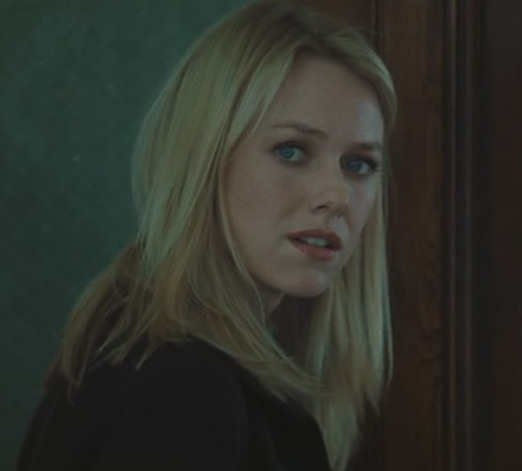
Sidebar: I might have developed a bit of a crush on Naomi Watts when this movie came out. Crush, as it turns out, still active.
Rachel’s a career-driven single mom of a son who spends his time apparently engaging in extrasensory perception normal kid things and drawing seriously disturbing totally normal pictures at all times:

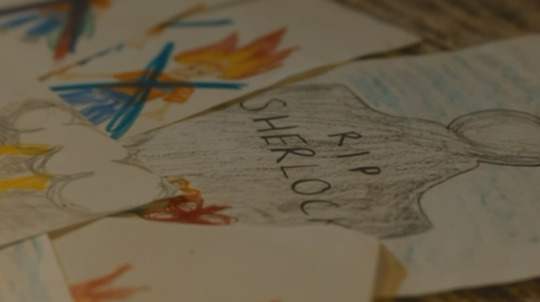
(Not yet, Eurus!)
The story of The Ring starts when Rachel’s teenaged niece dies under mysterious circumstances, and Rachel’s sister, the dead girl’s mother, asks Rachel to investigate. The trail leads Rachel to what sounds like an urban legend about a cursed videotape.
She finds the tape at a creepy mountain resort, and watches it. It is, in essence, a mishmash of images set to an unsettling minimalist soundtrack:
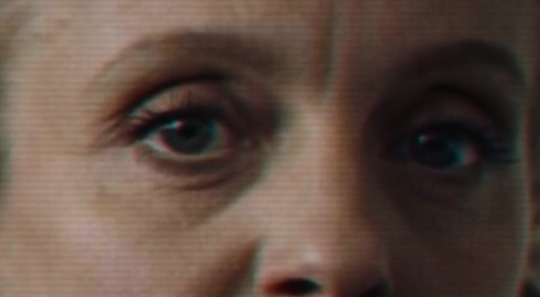
Sorry, wrong creepy recording. This is the one from The Ring:




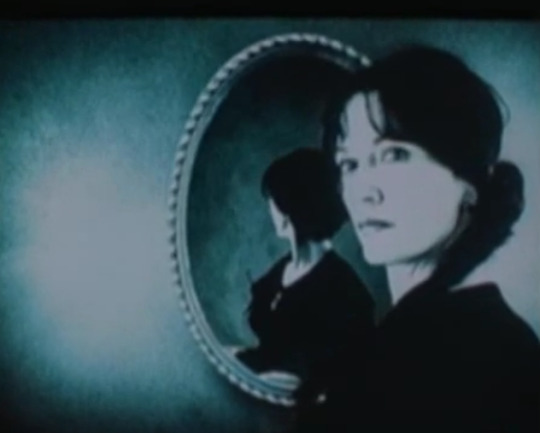


Yeah me too. (Note the nearly-fourth-wall-breaking gaze...remind you of anything?)

Hi, John. (Via @inevitably-johnlocked, specifically this answer.)
I’ll just say here that, in addition to seemingly casting himself as Plane Girl and Eurus throughout parts of TFP, John’s role as John in TFP overlaps with much of Rachel’s in The Ring. Rachel’s standout characteristics are her dogged attachment to the investigation and her somewhat deadbeat qualities as a mom. I’ll leave you to your deductions about why John probably identifies with her.
Immediately after Rachel watches the tape, the phone rings. When Rachel answers, a voice says, “Seven days.” We already know, from her previous investigations, that people die seven days after they watch the tape. Now she knows there’s something to the story, and we have a ticking clock motif--a handy thing that builds extra tension into any plot.

Tick tick tick, Jim!
I’m going to skip most of the investigative twists and turns in The Ring, because this movie is a treat, and half the fun is watching the evidence pile up that something supernatural is responsible for the mysterious deaths.
Long story short, Rachel’s investigations lead her to discover that the videotape is linked to a horse-loving couple whose possibly weird-scientifically conceived daughter caused a lot of trouble during her brief lifetime.
Oh, and they live on a remote island that you can only reach via boat.

Sorry, wrong island.
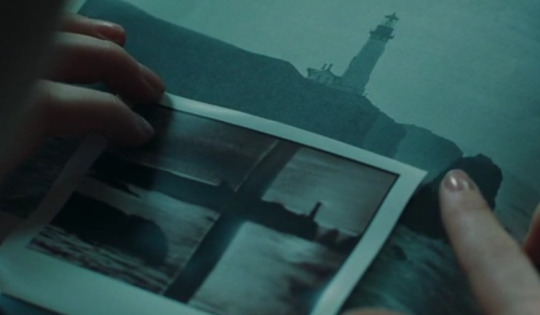
This weird island is the one from The Ring. Totally different island. This is the one where, while the weird girl with psychic powers was still alive, she seems to have subjected the residents to her whim. (*cough cough cough*)
ANYWAY--
Rachel interviews the girl’s father and gets nowhere, but the island’s doctor is a little more talkative.
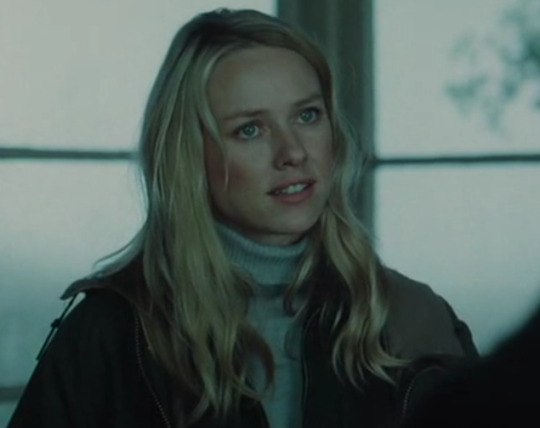

Important Backstory Alert:
Doctor: She wanted a child more than anything, poor Anna. They tried hard for years, but sometimes it’s just not meant to be. Then one winter they went away, and when they came back, it was with Samara. [I have to interject here to say you could argue that watching the tape means you have an APPOINTMENT WITH SAMARA, lol] ... Everything was fine, ’til Anna started coming to see me. Said she was suffering visions, seeing things, horrible things, like they’d been burned inside her. It only happened around Samara, that the girl put them there.
Okay. I just want to put a pin in that and go to TFP, because this is where we get some major intertextual action:
MYCROFT (firmly): I am aware of the dangers Eurus poses, and equipped to deal with them.
JOHN: What dangers?
MYCROFT (straightening up): Eurus doesn’t just talk to people. She ... reprograms them.
(John turns back to look at the screen.)
MYCROFT: Anyone who spends time with her is automatically compromised.
(all transcripts via Ariane de Vere)
Eurus is like the little girl from The Ring, putting ideas in people’s heads. As many, many people have noted, her hair and clothing in TFP are very close to Samara’s.

See what I mean?

Like Eurus, we see Samara through a television screen. Here, Samara is depicted in old footage of a psychiatric interview:

One of many iterations of televisual Eurus:
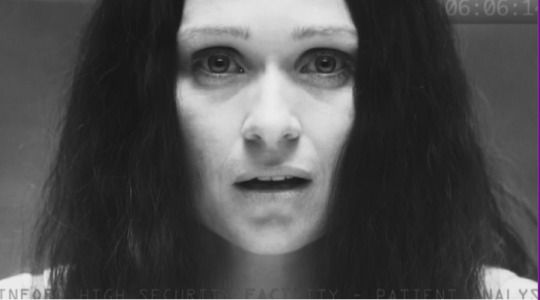
(The Ring plays very substantially with the uncanny nature of television, its habit of invading our domestic spaces, and the way that we can be manipulated and even threatened through the set. I suspect there’s something similar going on with TFP, especially in light of increasing evidence that it’s the setup to an ARG--TFP is the bait, the inciting incident, that leads us into the game.)
In any case, Eurus, as we have her in TFP, is an interesting mix of Samara from The Ring and a figure from John and Sherlock’s past. In The Ring, Samara manipulates people by “showing them things”--she puts pictures in their heads. But Eurus “talks to people,” and, somehow, makes them do things.

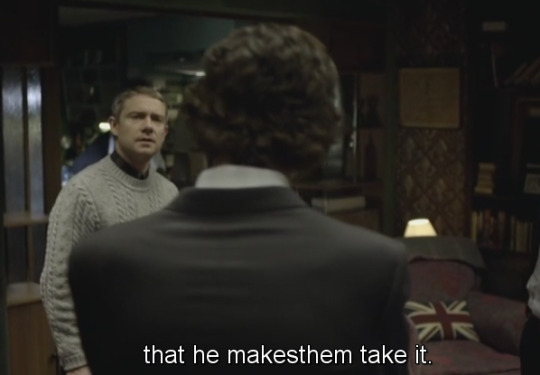
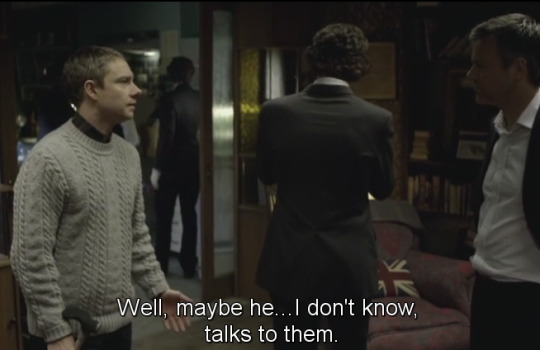
In TAB, on his way to his death, Sherlock read John’s blog, the story of how they met. Here, in TFP, on the verge of death, John is hallucinating a blend of motifs from horror movies and that same story--the story of how he and Sherlock met, with their first bad guy (Jeff Hope) blended together with their most recent (Eurus), and a substantial dose of Samara in the mix.
All of this evidence is plentiful enough to say there’s definitely a connection between The Ring and TFP. None of this begins to cover the sheer lunacy of the climax of TFP, and its very, very strong resemblance to the penultimate plot points of The Ring. Buckle in for a trip to bonkersland.
The Ring’s False Climax and The Non-Finality of TFP
The action of The Ring comes to its first, and fake, climax, as Rachel is running out of time. It’s the seventh day of her seven-day adventure, and she’s on Murder Moesko Island trying to figure it all out. Even as her previous ex-commander ex-boyfriend, Noah, struggles to dig up some information on the Morgans’ daughter at a nearby mental hospital, Rachel sneaks into the Morgan family farmhouse and watches a tape from the hospital’s archive:
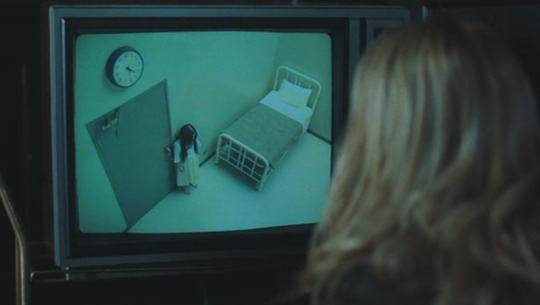



Interviewer: So what is it that’s keeping you awake? You must sleep sometime. Do you dream about something? Samara?

Interviewer: Let’s talk about the pictures. How did you make them? Samara? How did you make these pictures?
[Sidebar: the pictures are amazing]

Samara: I don’t make them. I see them, and then, they just are.
Interviewer: Samara, I need you to start telling me the truth, okay?
Samara: Can I see my Mommy?
Interviewer: No, Samara, not until we understand what’s wrong with you.
Samara: I love my Mommy.
Interviewer: Yes you do. But you don’t want to hurt her any more, now, do you? You don’t want to hurt anyone.
Samara: But I do, and I’m sorry. It won’t stop.
Interviewer: Well that’s why you’re here. So I can help you to make it stop.
Samara: He’s going to leave me here.
Interviewer: Who?
Samara: Daddy.
Interviewer: They just want to help you.
Samara: Not Daddy.
Interviewer: Your Daddy loves you.
Samara: Daddy loves the horses. He wants me to go away.
Interviewer: No he doesn’t.
Samara: But he doesn’t know.
Interviewer: He doesn’t know what? Samara?
[The tape cuts off.]
This is lovely horror movie stuff, well done. (If anyone wants to explore the above text in terms of potential connections with John, Mary, and Rosie, or in light of Eurus’s nonsense monologues / psychiatric interviews in the background of TFP, go ahead. I’m not planning to, but I think it’s a potentially rich vein.)
We have the evidence that there was something very wrong with Samara, and the witness (Rachel) who interprets what she sees as evidence of child abuse. As The Ring builds to a series of reveals, we’re pulled in two different directions: we have the evidence that this child has powers, that she’s used them malevolently, and, on the other hand, the idea that she should have been protected, she was just a child, and therefore can’t be responsible for what’s happened to her.

Rachel, persisting in her idea that Samara just needed / needs to be understood, and that she’s uncovered some terrible story of abuse, continues to investigate.
Similarly, the narrative of TFP pulls us in two different directions. Eurus is both a little girl who somehow just needs a hug, and the demon seed who had, and has, no trouble killing wantonly.
Since Eurus can be read as a proxy for John (and this is part of where TFP takes on serious dramatic weight), we have both sides of him, as well. John needs to be rescued.

John is also full of self-blame.

He casts himself in both roles, with one resolution: his own rescue.

In The Ring, Rachel, now joined by her previous ex-commander ex-boyfriend Noah, first SEEK MY ROOM find Samara’s room, which is located in a symbolic Rapunzel’s tower hello damsel in distress at the top of the world’s tallest barn:
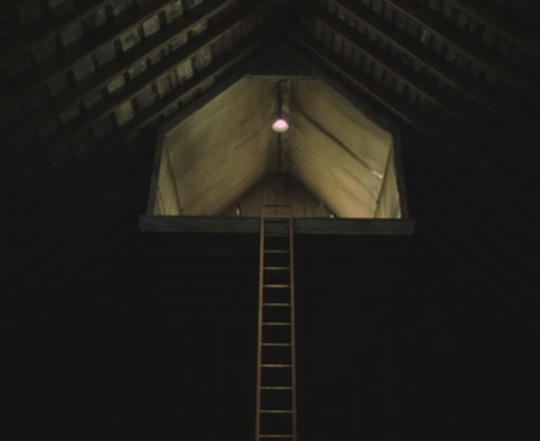
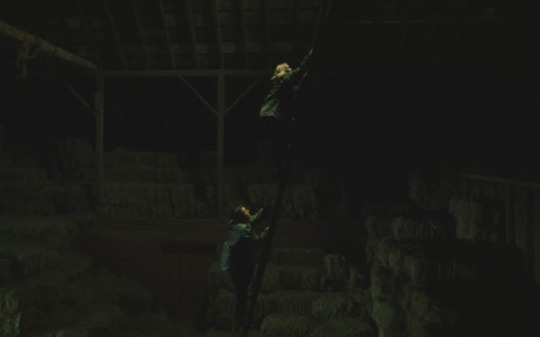
After approximately fifteen minutes of climbing, they find this oddly-normal-looking-for-where-it-is little girl’s room:
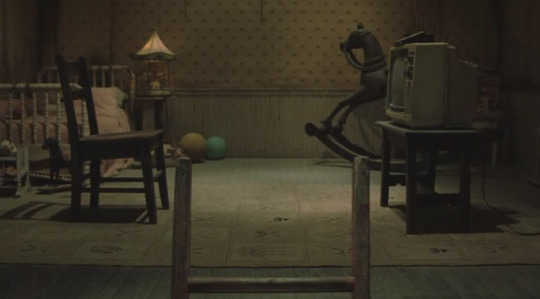
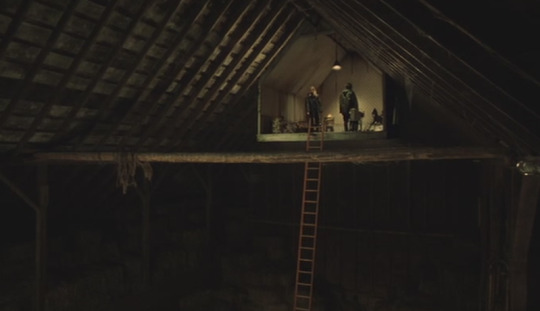
Compare:

Samara’s room, like Eurus’s apparently normal childhood bedroom, hides darker intentions and secrets. In this case, hidden under the wallpaper:
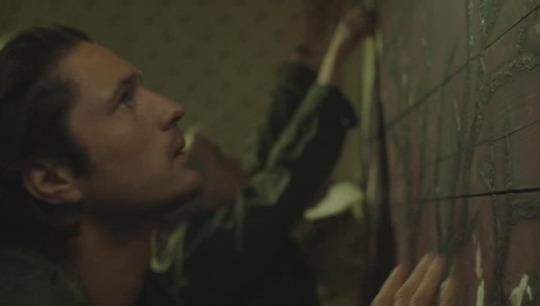

The burning tree image they uncover is a clue that leads them back to the inn where Rachel first watched the tape.
There, in the cabin, Noah and Rachel search desperately for the reason why they’ve been led back to this place. Rachel makes an impassioned plea for Noah to help their son (who has also watched the tape, and is under the same curse). Noah temper tantrums spectacularly--

--Noah temper tantrums spectacularly, knocking a conveniently placed vase of glass beads onto the floor. They roll and form an arrow that points to the solution:



(Did I mention that the room in The Ring is “painted red” by the setting sun shining through the red leaves of a tree? Just saying.)
Rachel and Noah figure out that there’s a hidden well underneath the floorboards on the cabin. Noah fetches an ax and smashes up the floor, an act that takes approximately a million years of screentime but is very manly:

Go, Sherlock!
Go, Noah!



What is it called when you break through the floor instead of the fourth wall? Lol.

Here’s where things get really ridiculous.
A tv, possessed by the spirit of the dead girl, knocks Rachel into the well.
No, really:

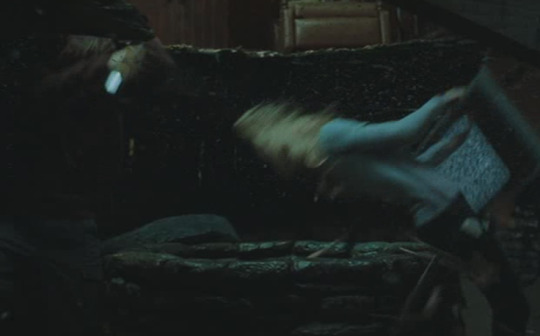
I know, totally different from being put in a well by a person who broadcasts herself through a tv and who everyone thought was dead, but you know.
The fall knocks Rachel out. She wakes up in the well:
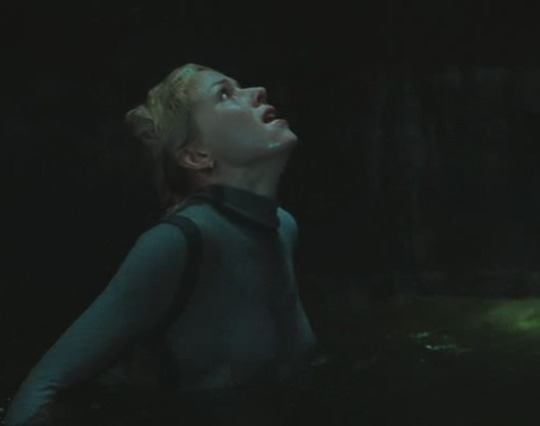
Rachel: I’m here.
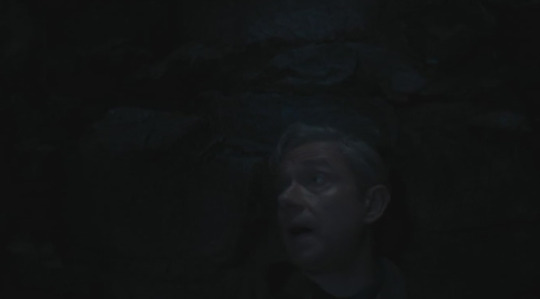
John: Yeah I’m here.
Rachel finds gruesome evidence that Samara was trapped in the well, alive, for a while.
The lid slides over the well--Rachel is trapped. She pulls up a handful of hair from the water, a hand emerges to grip her wrist, and we’re off into flashback territory:

Rachel receives a vision, presented as a flashback, about Samara’s murder. At first we see what seems to be a childhood idyll, accompanied by Samara’s singing:
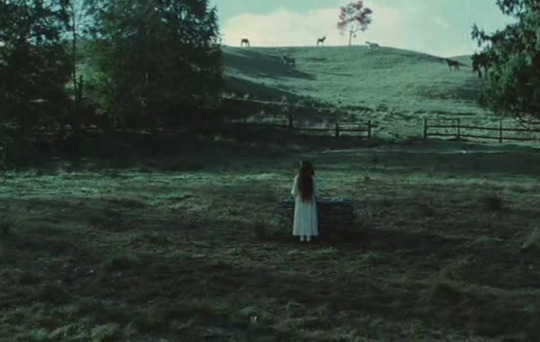
Round we go
The world is spinning
When it stops
It's just beginning
Sun comes up
We live and we cry
Sun goes down
And then we all die
[x]

But, we find out that this is actually the scene of her murder, as her mother approaches from behind her, puts a plastic bag over her head, and pushes her into the well:

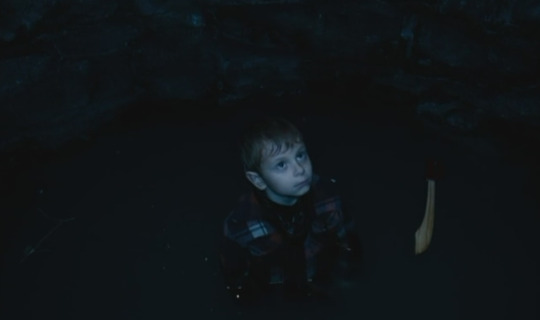
Meanwhile, at the bottom of the well, Rachel pulls Samara’s body up out of the water. She comforts her:

Rachel: It’s okay now. It’s okay.
This parallels Sherlock’s puzzle solving on the surface, so he can find Eurus and save John.
SHERLOCK: I ... am ... lost ... Help ... me ... brother ... Save ... My ... Life ... Before ... my ... Doom.
(He continues swiping the words away.)
SHERLOCK: I ... am ... Lost ... Without ... your ... love ... Save ... My ... soul ... seek ... my ... room. [x]
The gravestone puzzle allows him to find Eurus, and comfort her.
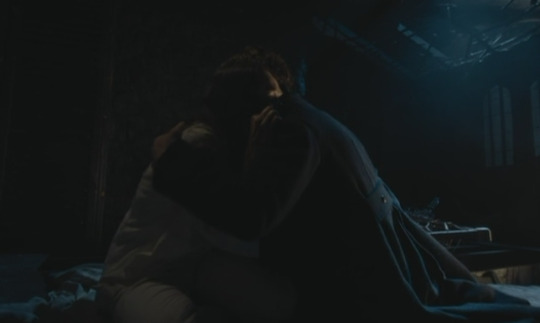
SHERLOCK (in a whisper): You’re not lost any more.
Here we have it: a clear emotional climax for TFP--the climax that happened instead of the emotional resolution we were looking for, between John and Sherlock, but a climax nonetheless, if only in strictly structural terms.
In The Ring, this is the moment Samara’s body dissolves into bones:
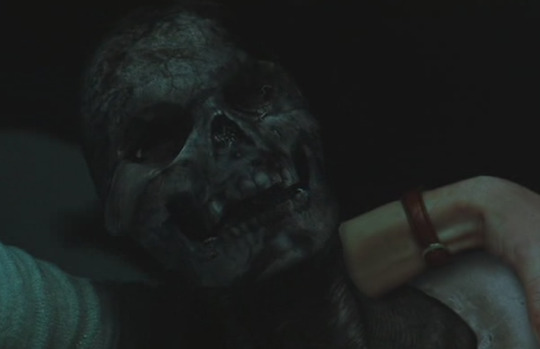
Meanwhile, in John’s Well of Feels:

This moment in The Ring offers an escape from death for John Rachel. The curse doesn’t kick in: she doesn’t die, even though her seven days are up. She believes that, in discovering the true story of Redbeard Samara, she’s solved the puzzle and broken the curse. She contemplates the importance of understanding Samara, in the aftermath, as a surprising number of emergency workers and police crowd around this remote location, no doubt in response to Noah’s and Rachel’s call.
The Ring:

TFP:

Noah talks with Rachel about what happened, comforting her as she’s wrapped in a shock blanket, looking tired and worn out and damp:

Rachel: [About Samara] She just wanted to be heard. Sometimes children, they yell or cry or draw pictures.
In case you’re having trouble telling at this point, this is from TFP, not The Ring:


John: Well, you gave her what she was looking for: context.
Sherlock: Is that good?
John: It’s not good, it’s not bad. It is what it is.
[And what it is, is shit, friends, or, more hopefully, about to go to shit in the most amazing way possible. Hang on: this meta has one more loop around the track to go.]
In both The Ring and TFP, this looks like closure, doesn’t it? It looks like the show’s over. TFP certainly did its darndest to pantomime an ending after this. And yet--
WHY IT ISN’T OVER YET
Now we come to the point, the entire point and the thing that inspired this post. If John is drawing inspiration from The Ring in his hallucination--and I am certainly convinced that he is--then we ARE NOT DONE.
The above is not the climax of The Ring. It’s a nice version of a ghost story: if someone could only just learn the truth, then we could put the haunting to rest.
What a tender world that would be.
Rachel goes home, and tells her son, who has also been cursed, that she solved the puzzle.
Aidan: What happened to the girl?
Rachel: Samara?
Aidan: Is that her name?
Rachel: Mm hm.
Aidan: Is she still in the dark place?
Rachel: No. We set her free.
Aidan: You helped her?
Rachel: Yeah.
Aidan: Why did you do that?
Rachel: What’s wrong, honey?
Aidan: You weren’t supposed to help her.
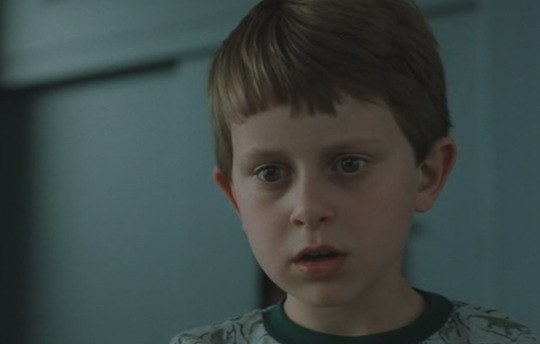
[^ my approximate feelings immediately after watching TFP for the first time.]
Okay so, let me fill you in on how freaking amazing The Ring was, as a first time viewing experience, when it came out. Horror had, as horror does, gone through a particularly shitty slump at this point. The decision to import motifs from J-horror was among one of the best things that could have happened to Hollywood, however you feel about cultural appropriation / this style of collaboration. The above moment, in which the not-at-all-creepy child informs Rachel that she is wrong, that she has in fact made a terrible mistake, was, simply put, a really standout moment in the history of horror cinema. It was the thing that people talked about when they talked about The Ring.
The false climax of The Ring is the thing that distinguishes it. Borrowing that false climax to the point where, beat for beat, it informs the climax of your horror pastiche episode, as Moftiss have done in TFP, is akin to jumping up and down and screaming, THERE! IS! A! TWIST! COMING! THIS! IS! NOT! OVER!
So, what’s still to come?
In The Ring, the twist is that Rachel actually avoided the curse when she made a copy of the videotape, during her research. Like a smart virus, Samara’s curse forgives the person who propagates it.
If you don’t pass it on, you die. The curse is very much still active in the world of The Ring, which we find out when it gets Noah (poor Noah!). Here we learn the true nature of death-by-Samara. Basically, she breaks the fourth wall, climbing through your television set to come get you:

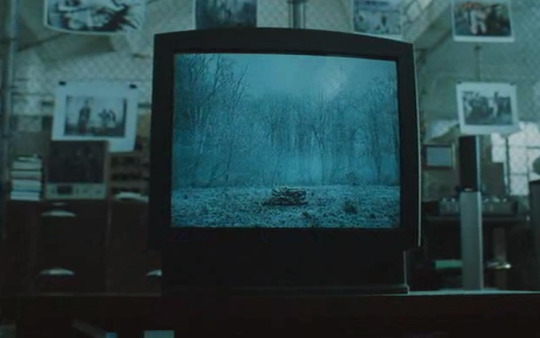
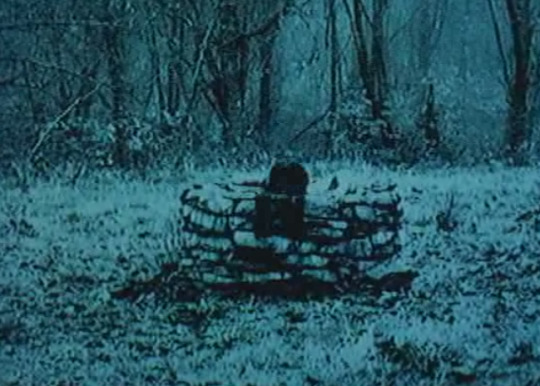

A fourth wall break so extreme, it’s lethal!
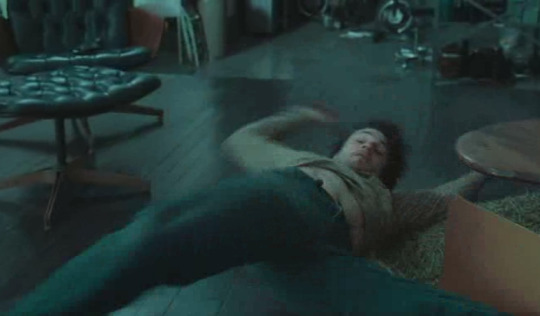
I know, Noah, this is how I feel about the ARG too.
Noah dies, leaving Rachel to figure out that the key to saving her son from the curse is to have him copy the tape:

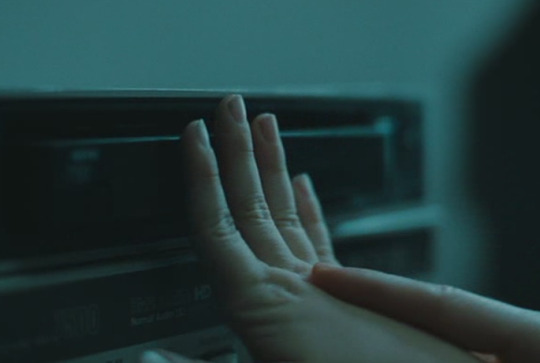
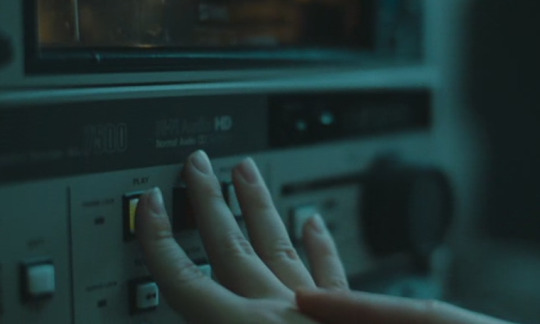
This is Moftiss, showing you how to hit reblog on those ARG posts that you find scary, but which somehow seem increasingly important to your survival, post s4.
Bottom line, the ending of TFP, in copying the false climax of The Ring--in addition to its numerous other signs that it is not seriously offering any kind of resolution or closure for its audience--indicates that it is fake as hell. The story is not over, there is more coming for our heroes, and much more coming for us.
tagging:
@devoursjohnlock @marcespot @waitedforgarridebs @221bloodnun @jenna221b
I should probably tag others but I’m exhausted, please feel free to pass this on.
518 notes
·
View notes
Text
Doctor Strange Review
I enjoyed Doctor Strange, but also felt it was average, ranking somewhere in the middle of Marvel Studios’ pack. I know next to nothing about Dr. Strange, having only seen him in guest appearances in various Marvel cartoons and an animated film a while back, so I went in with no expectations. I walked out thinking the movie was a fun adventure, but wanting more from Strange’s character development, less formula in the plot, and more weirdness in general.
Light spoilers...
There's a lot of familiarity to Dr. Stephen Strange, brilliant and arrogant jerk who's humbled (a little) into becoming a hero, so his origin and character arc felt routine and played out even with magic as a new window dressing. Strange’s dogged determination to know how everything works in this new field was one of his redeeming qualities, though, and one that set him a bit apart from the very similar Tony Stark. Strange was definitely a lot colder than I thought he'd be, however that point was brushed over in the movie and clashed with his later refusal to kill (see below for more). Benedict Cumberbatch was good with a variation on his "I'm smarter than everyone else and I know it" sensibility from Sherlock mixed with something of a toned-down Stark, but even considering he does have a learning curve, I still came away with the impression that everything came too easily for him. Even after setting up a long, arduous training process/montage by referring to how long it took him to become a brilliant surgeon and including a few moments where his skills fail him, it seems in a few months he's mastered sorcery others haven't in lifetimes. For example, he's able to operate a time device perfectly after one attempt and no further practice. He makes some mistakes and gets injured (and almost dies at one point), but outside of the kaleidoscope-city sequence, his mistakes don't have big consequences (and even that one didn't make an impact on me). To the movie’s credit, he also gets out of things through sheer luck sometimes. It might be the fact that this is part of a huge franchise, but I never felt like he might actually be in danger or that his powers could screw up the world in any irreparable way thanks to his inexperience. In hindsight, he's less perfect than my initial impression, but he's still hailed as something of a prodigy and it would've been better if he had to work harder or at least rely on others more.
Chiwetel Ejiofor was well-cast as Mordo and I liked his arc; it’s possibly the best one in the movie. Tilda Swinton was good as the Ancient One, but ultimately I didn't feel a connection to her character (and wish they’d kept the character’s original Asian ethnicity from the comics). Rachel McAdams’ Christine Palmer was written as a generic love interest without much of her own drive, so McAdams was wasted here. I enjoyed Benjamin Bratt’s small role as Jonathan Pangborn and the mundane magic he employed; it brought a nice variety to the magic usage in the world. Mads Mikkelsen was fine as Kaecilius, but barely felt like a presence (the same fate that’s befallen other minor Marvel villains). He and his cronies aren't all that three-dimensional either, but at least their attempt to grant everyone eternal life is an original motive. The biggest bad, on the other hand, was underwhelming both in terms of his plan—your typical “invade and take the Earth”—and his power output.
However, the visuals are outstanding! The chase/fight you've seen in the trailers with the twisty city and the one in the climax are both very cool and inventive, and definitely worth seeing on the big screen if you can still find it in theaters. I also loved that the climax is resolved without the usual superhero business. The imagery in Strange's first trip through the multiverse was very cool, but the rest of the movie only really touched on one other dimension and a Danger Room-esque pocket world, so the promise of impossibilities and infinite potential felt a little squandered here. Likewise, the mystical boot camp Strange goes to felt routine, like it was using pop culture shorthand for everything so that we’d accept it more easily instead of developing their own rules and really defying expectations. Luke Cage, for example, took the time to fully immerse the audience in the world of Cage’s Harlem, and even though Strange has a much shorter runtime, having Strange (and us) really feel out of his element would’ve been an improvement. I would’ve much preferred that the magical aspects of the film, the dimensions he visits, and the enemies he faces be far stranger—why should beings from other dimensions want anything similar to what plain old human enemies do, after all?
Michael Giacchino’s score is whimsically great and a welcome departure from the usual Marvel Studios scores, which tend to sound kinda similar. Some of the humor lands, like things his cape does and Stephen’s reactions to mysticism, while other bits don't at all, like what finally makes Wong (Benedict Wong) laugh. I think they had more hits than misses, though.
I realize this review sounds fairly negative, but I didn’t dislike the movie. Even with the MCU origin story formula showing (and wearing thin) more and more, I enjoyed myself. There’s no denying that this is a fun and inventive film; I’m more tired of origin story tropes than I am of Marvel films or superheroes in general. I’d be up for a sequel that more fully explores the multiverse and goes way weirder than this one dared to! Dive into magic and other realms with the same abandon that Guardians of the Galaxy had for space adventures!
Major Spoilers
The scene just before Strange’s car accident made him so much colder than any Marvel hero thus far, completely eliminating my sympathy for him, even if the writers didn't intend to paint him that darkly. I just don't see how to reconcile Strange refusing to take an “impossible” medical case because it could "screw up his perfect record" with his later argument that being a doctor means he won't kill. He also refused to take a case because it was beneath him/boring, which IMO goes beyond any semantics of killing vs. not trying (like Batman Begins tried to pull) and establishes a pattern of his self-aggrandizement that’s never resolved over the course of the movie, even if he does accept sacrificing himself to stop Dormammu.
I absolutely respect, love, and was surprised that the climax is solved with Strange's cunning rather than punching. Similarly, the reverse-time fight was awesome! That might be the most inventive superhero fight in a movie in a long time. That Dormammu is played by Cumberbatch—he’s a dark reflection of whomever he is speaking to at the moment, according to the director—is a nice touch.
One of the few things I knew about Strange from Spider-man cartoons was that Mordo was a villain, so I wasn't surprised by his turn, but I do think he had the best arc of the film and I'd be interested to see his anti-sorcerer quest continue.
I'm thoroughly confused by the post-credits scene with Thor. Why is Loki helping him look for Odin?? Loki was posing as Odin at the end of The Dark World...
I hope exploring the nine realms in Thor Ragnarok will help bring out the weirdness in Strange’s world!
0 notes